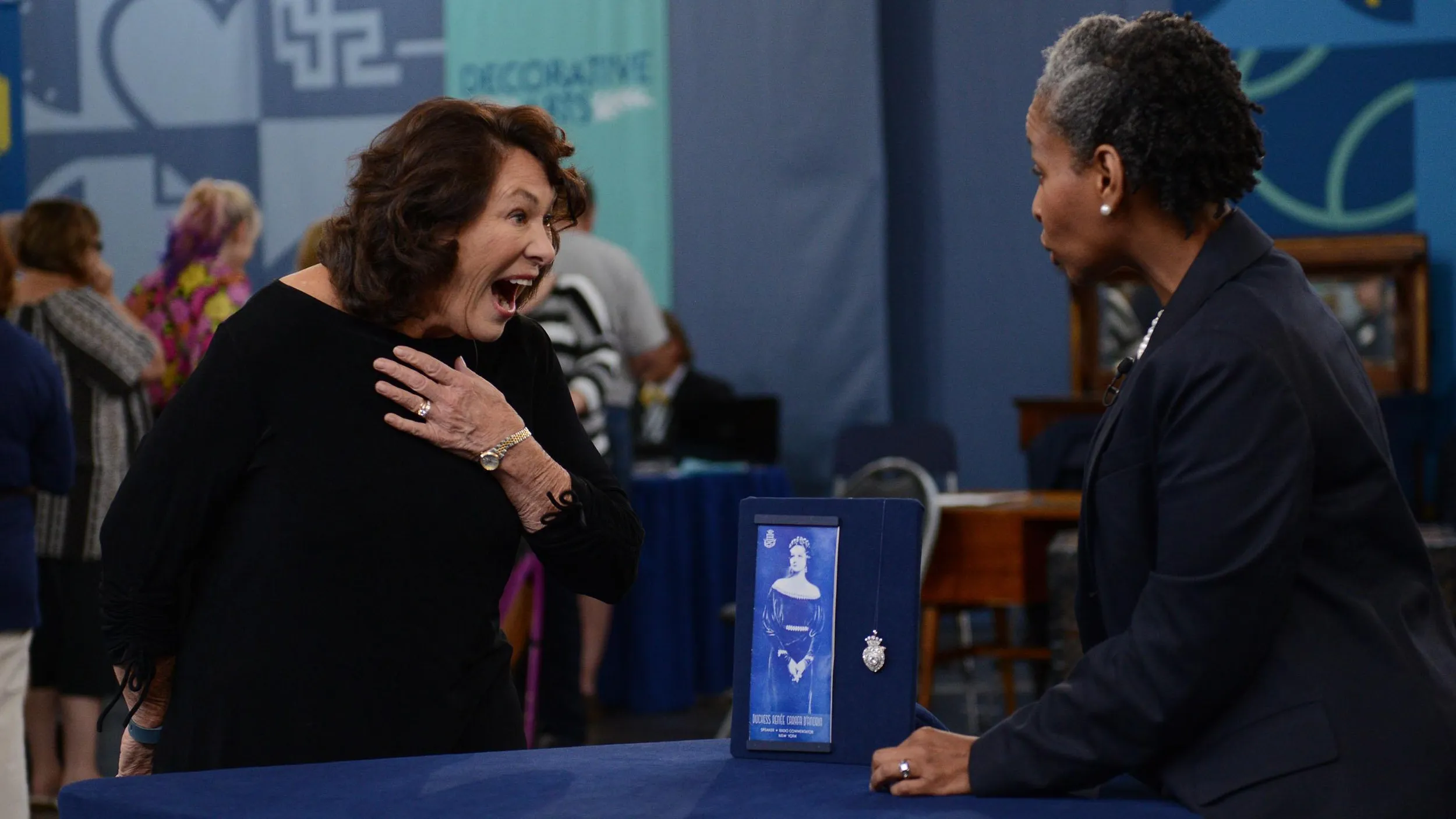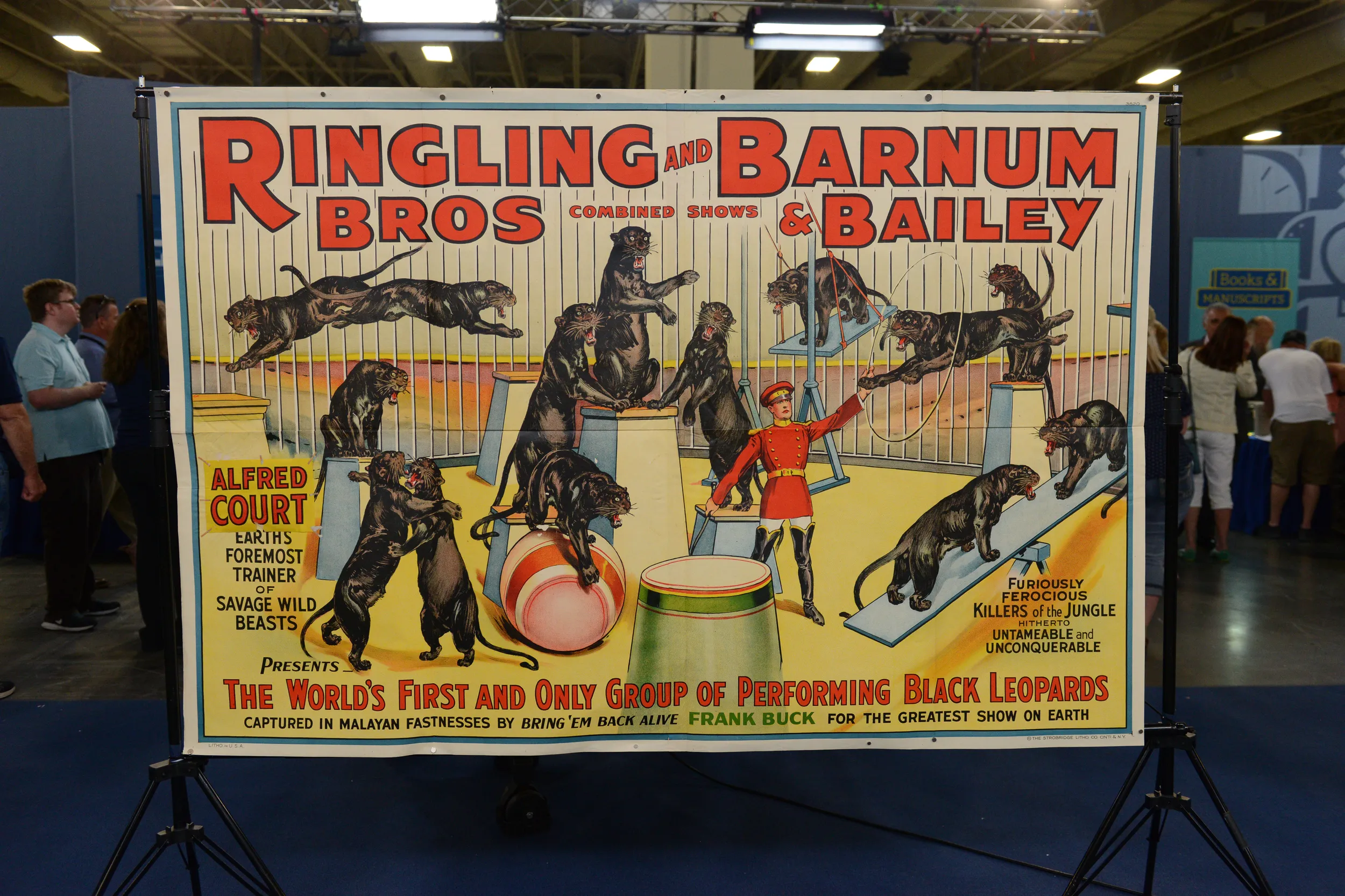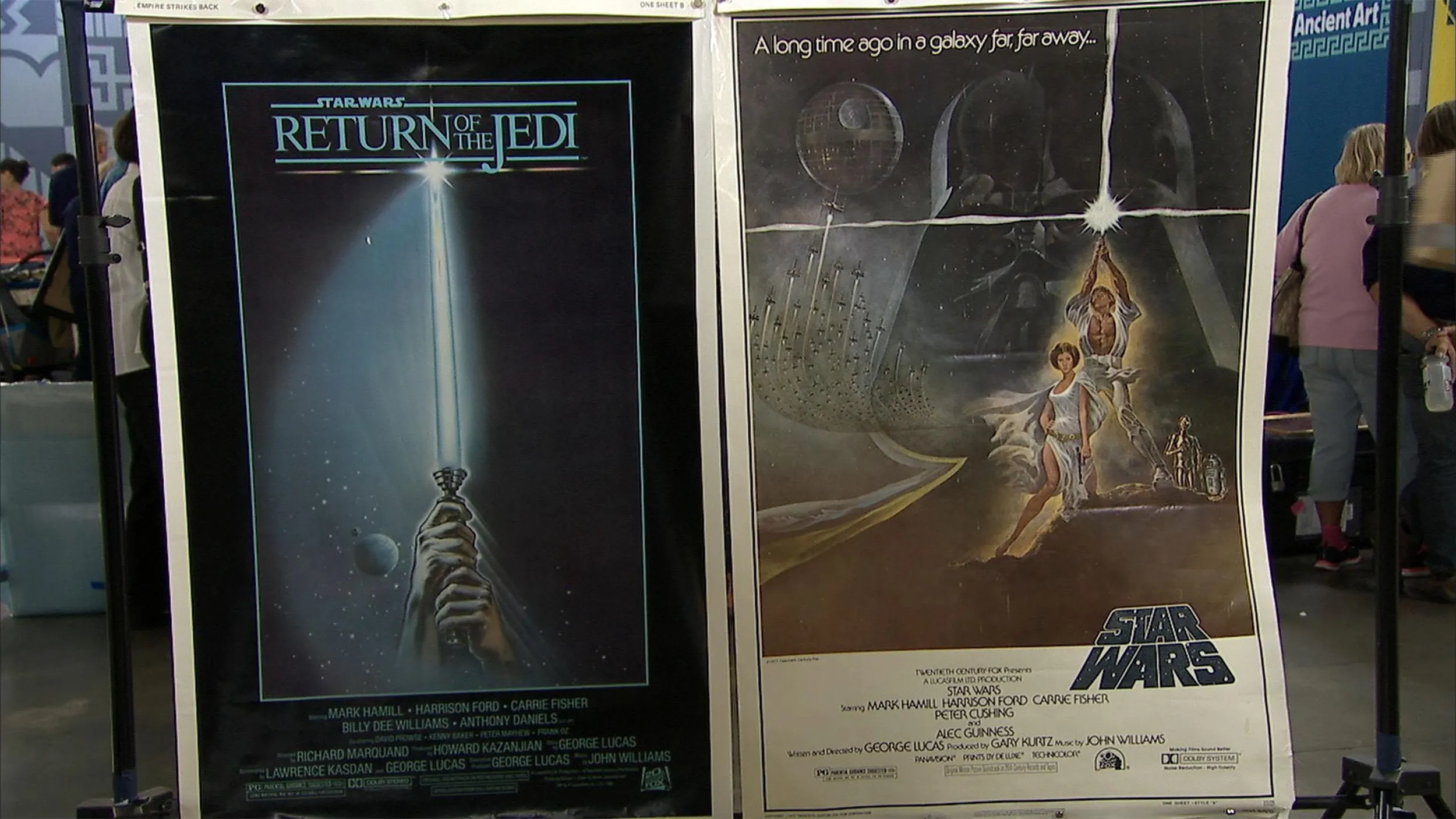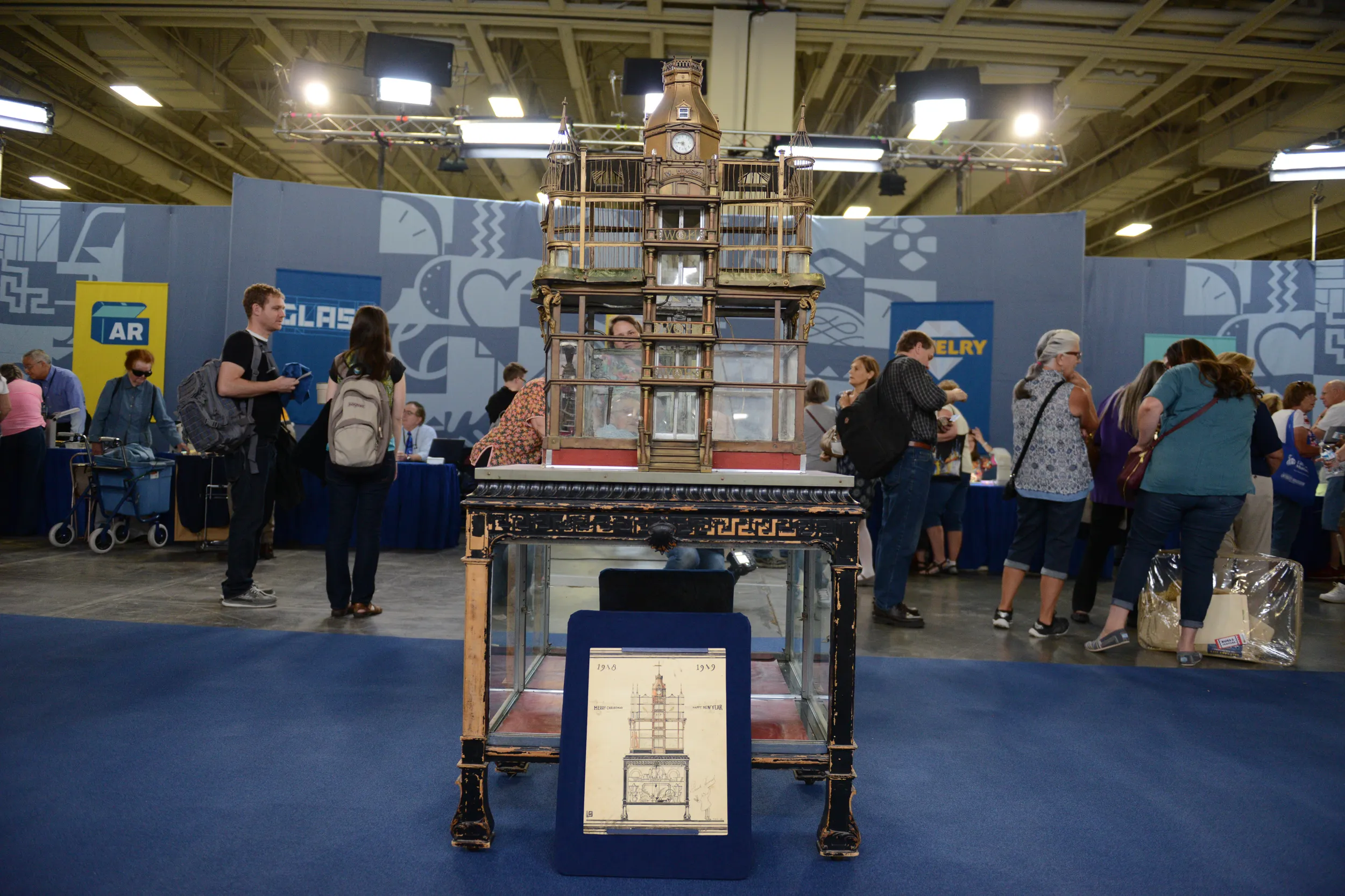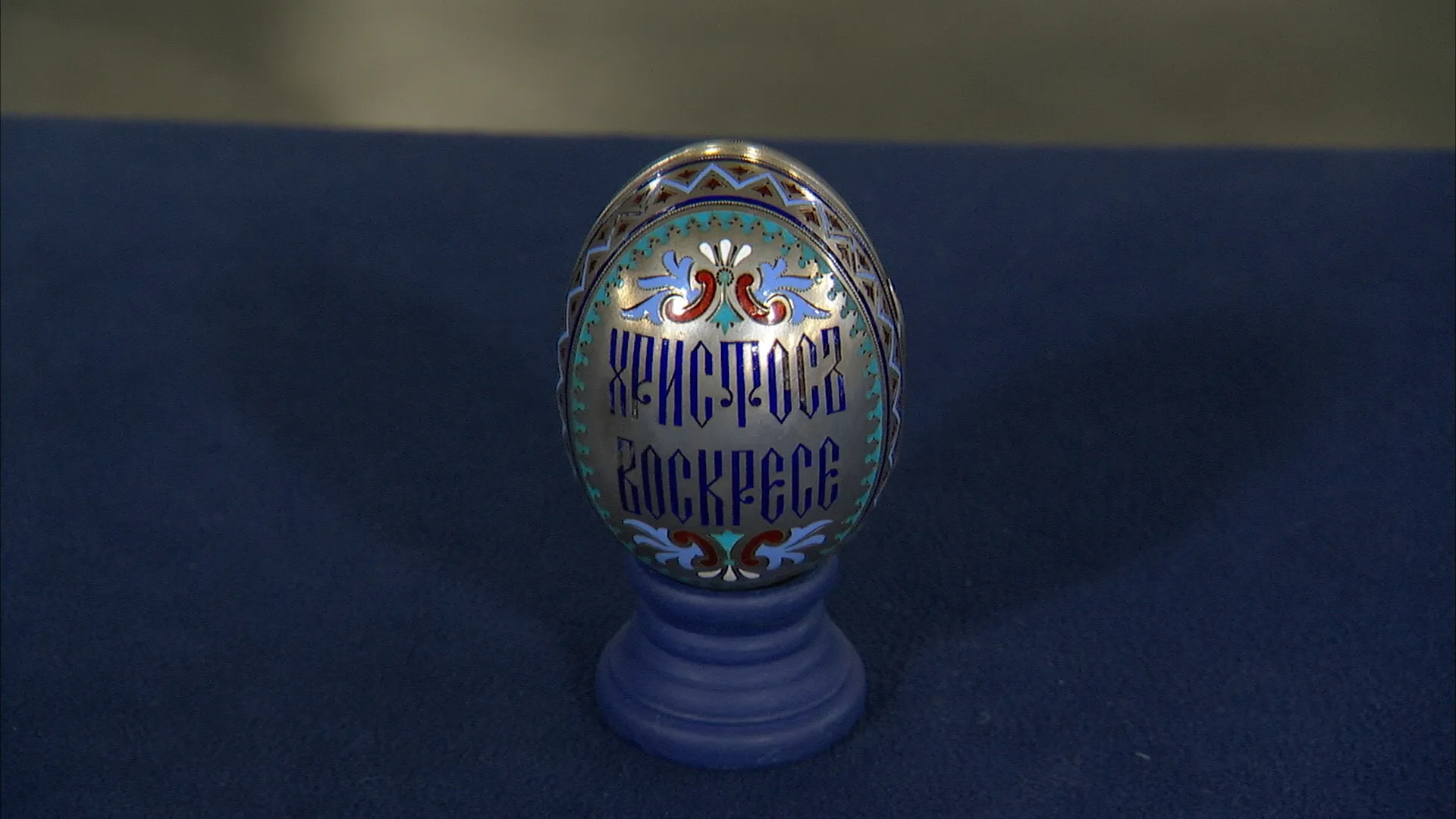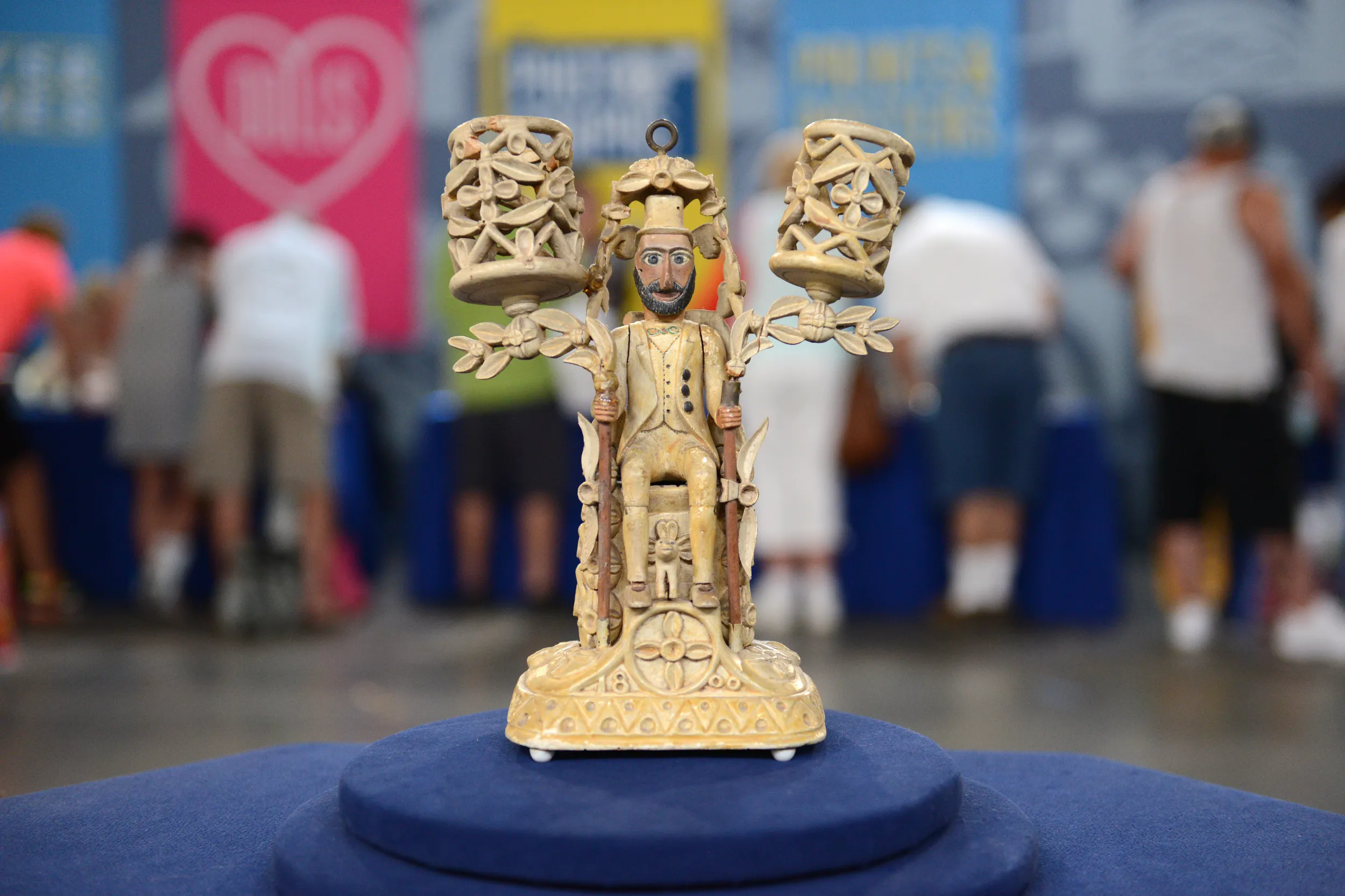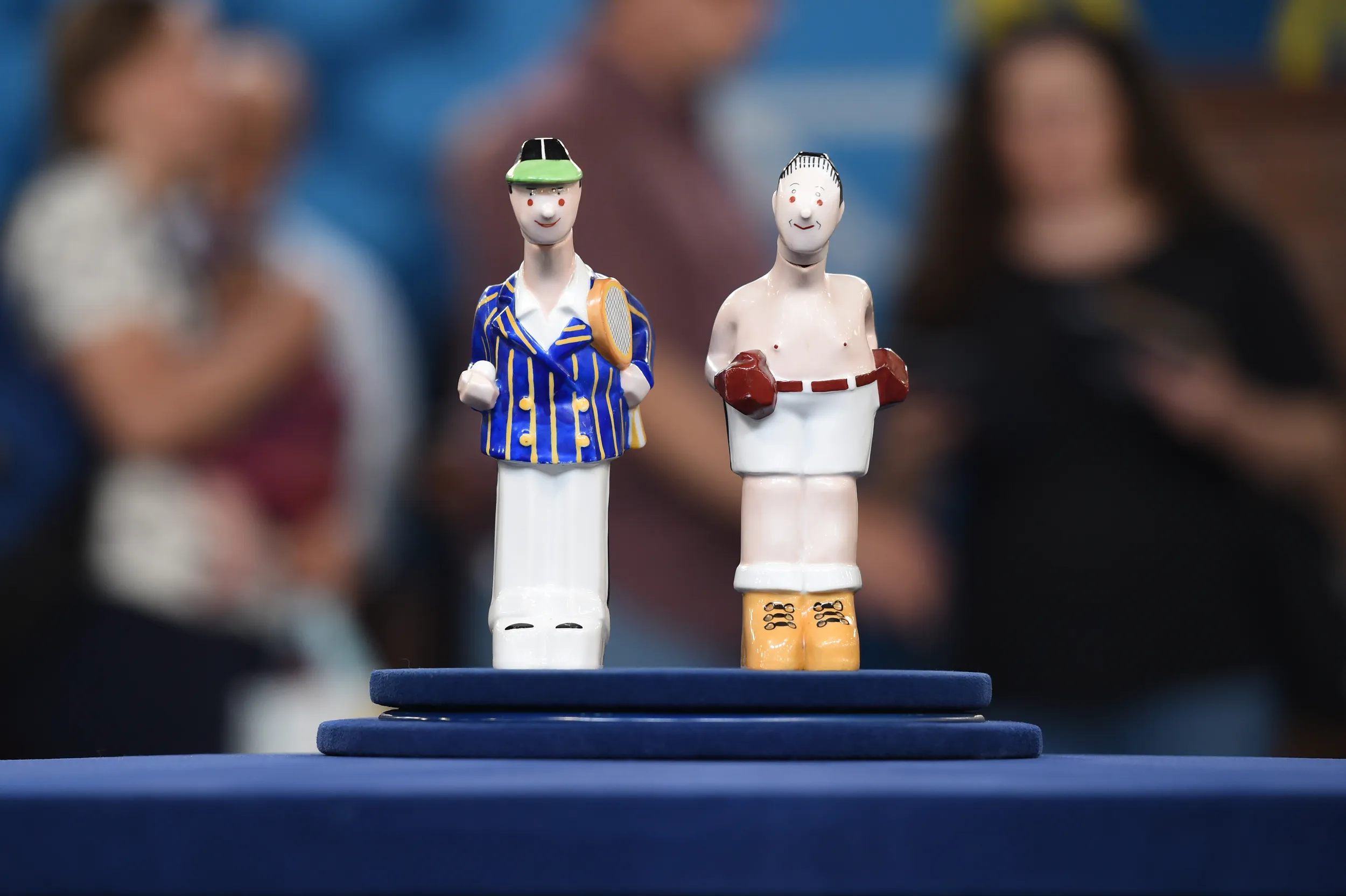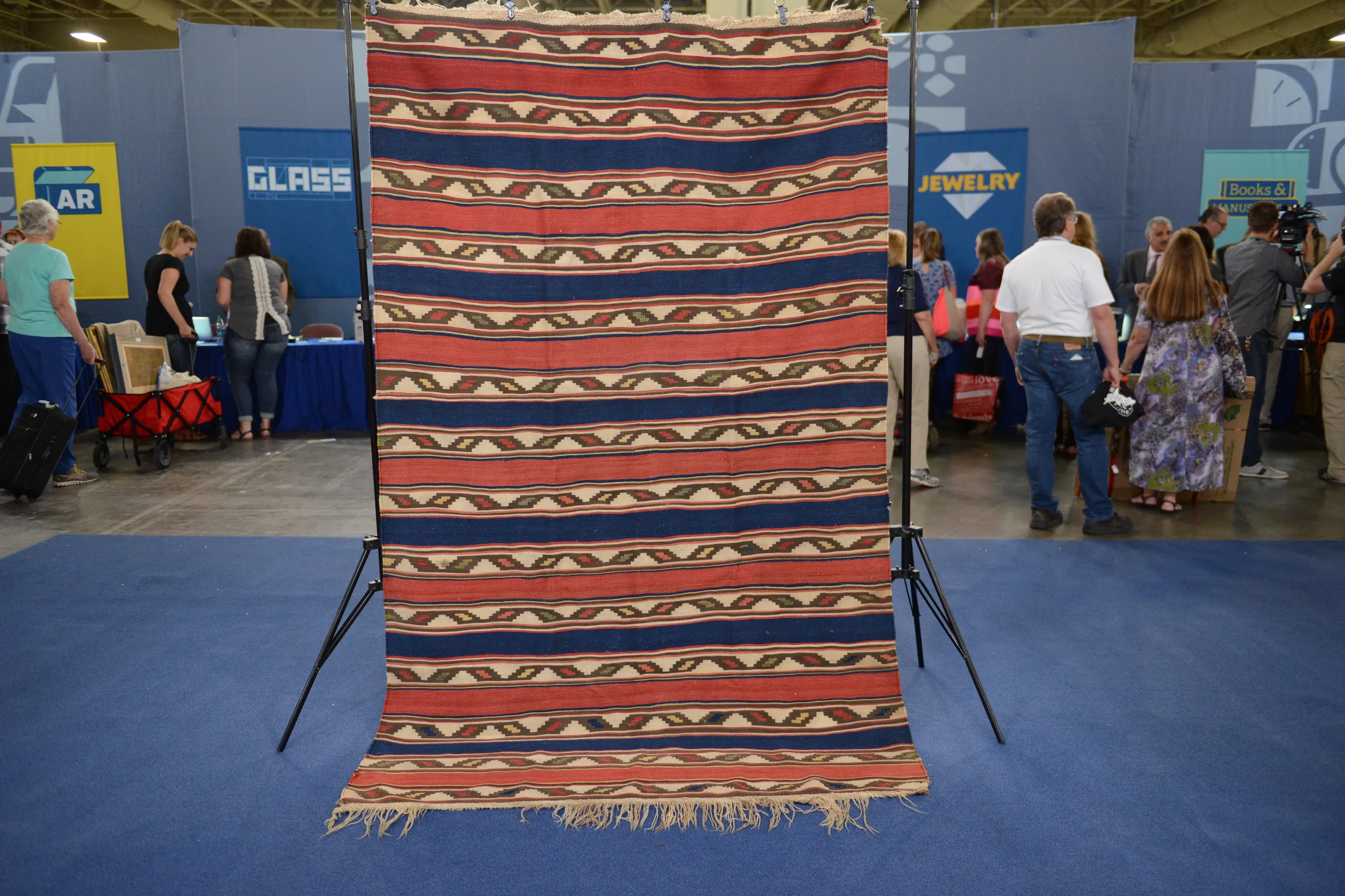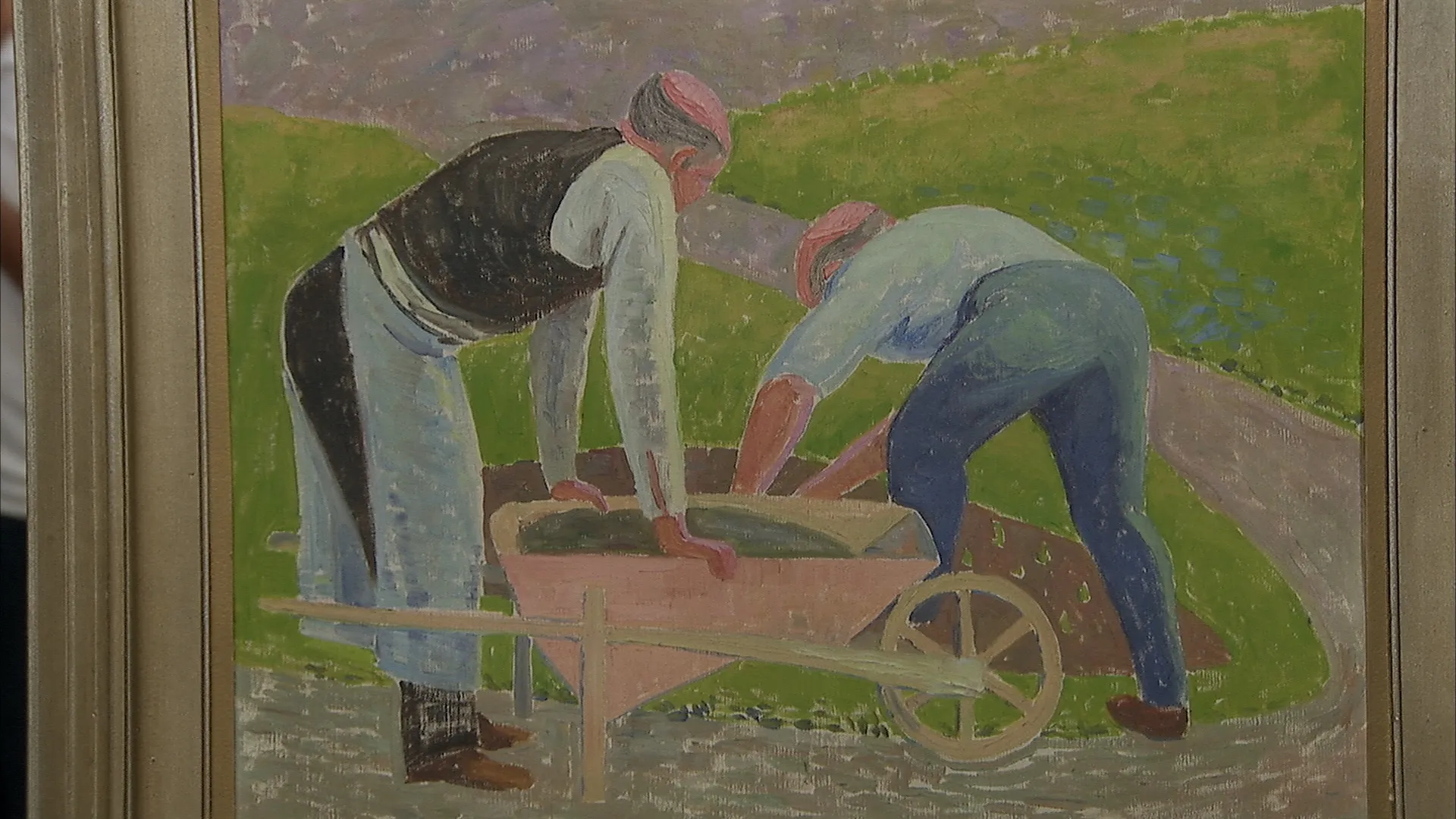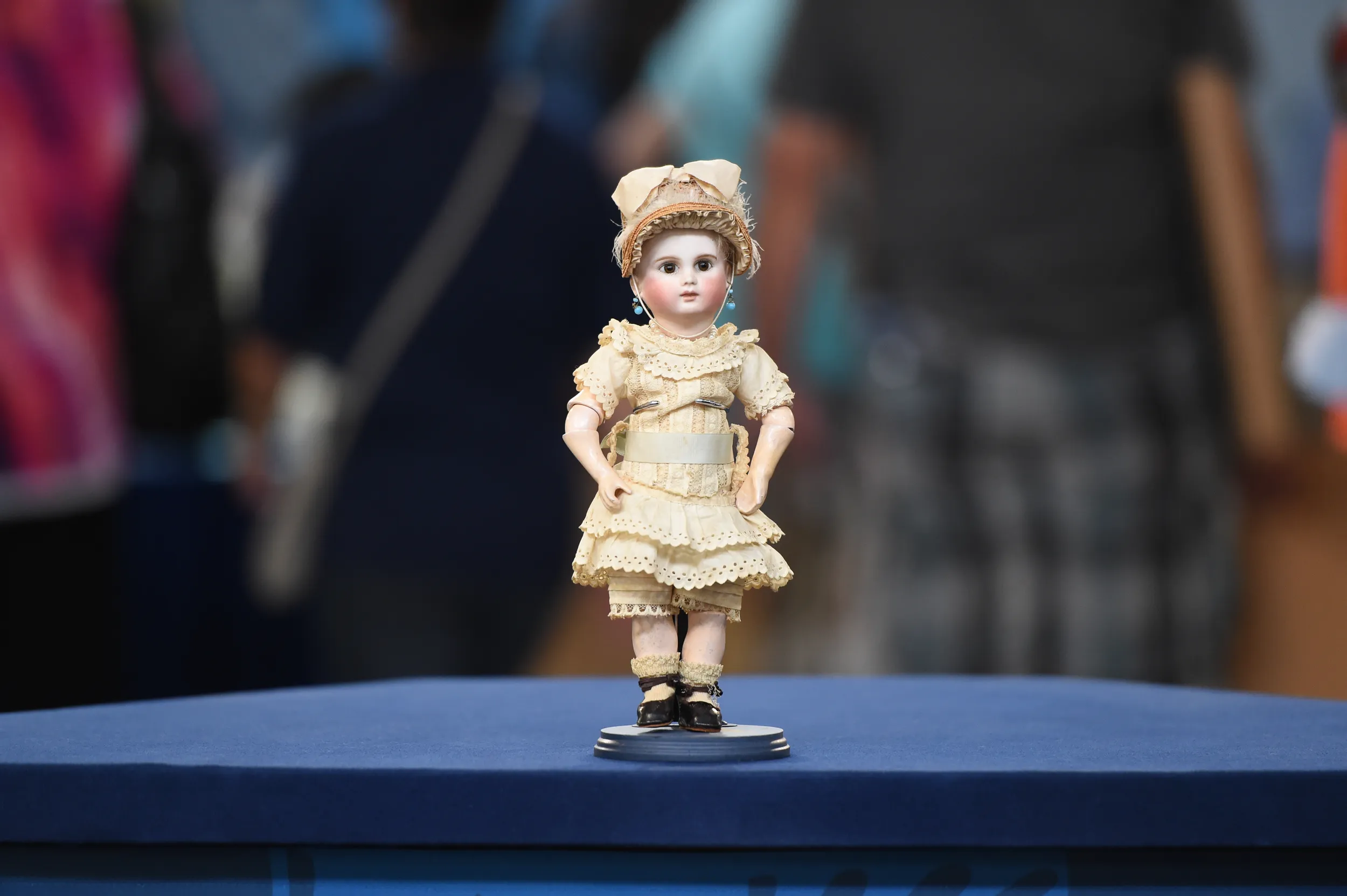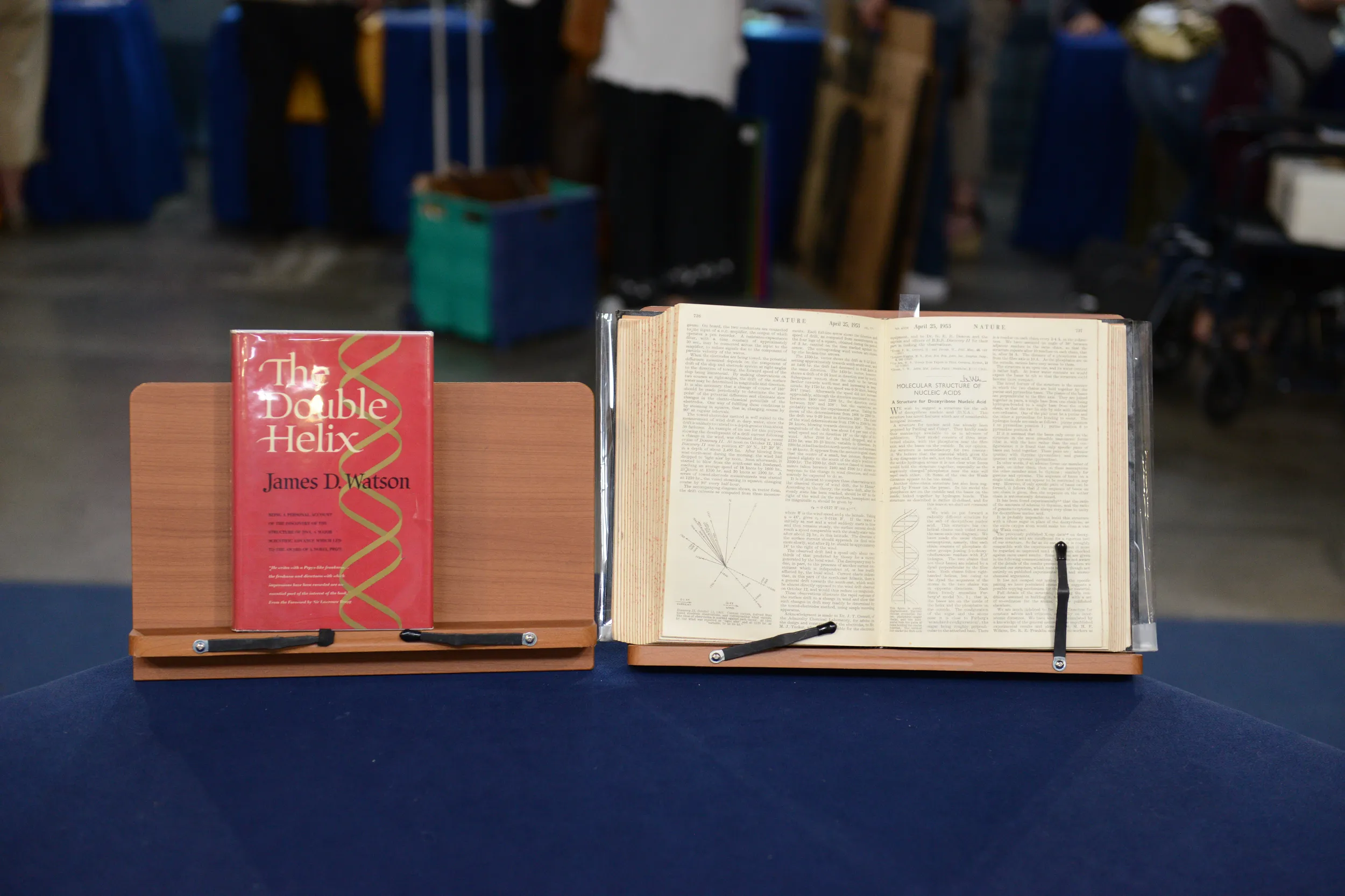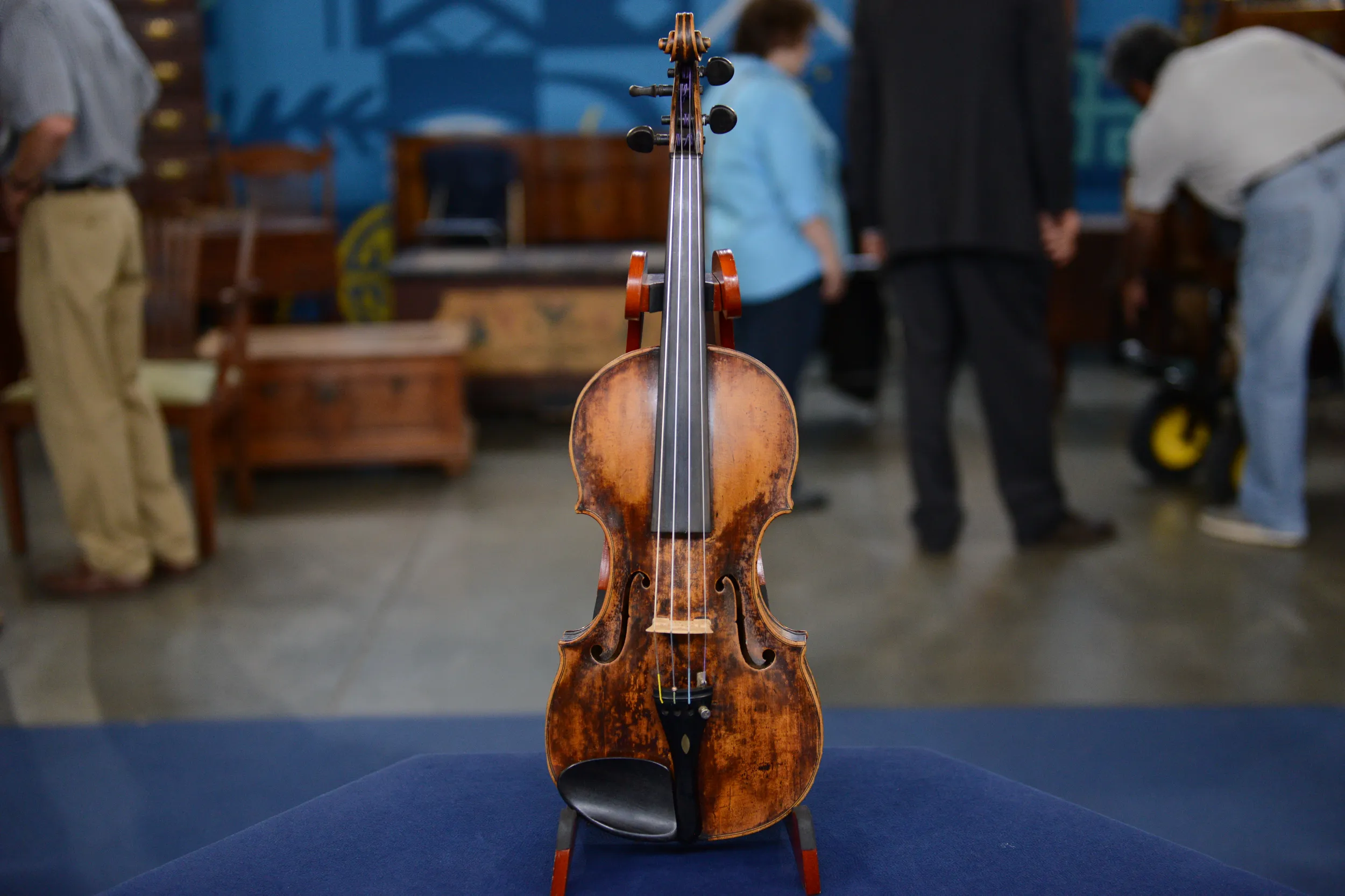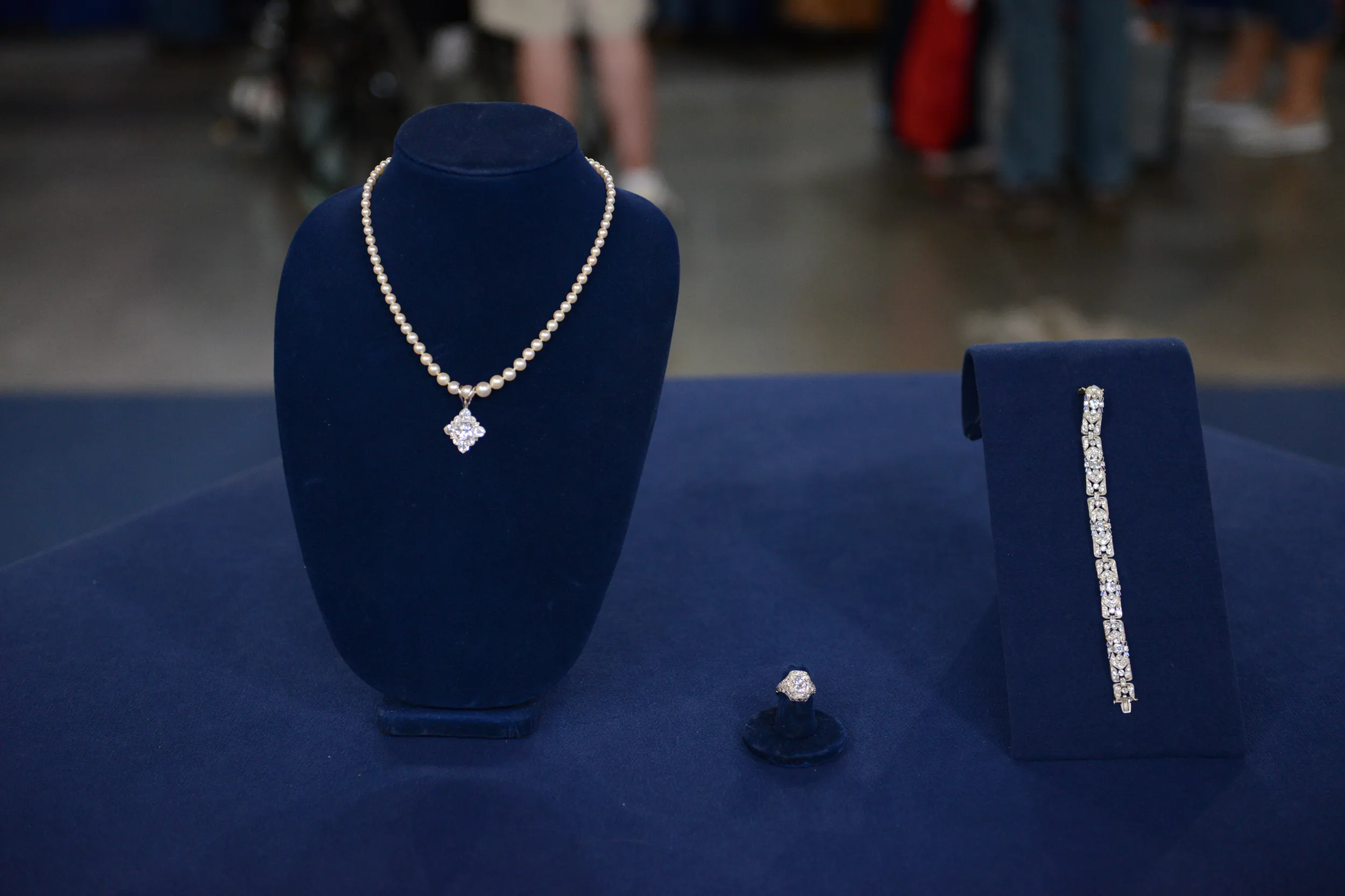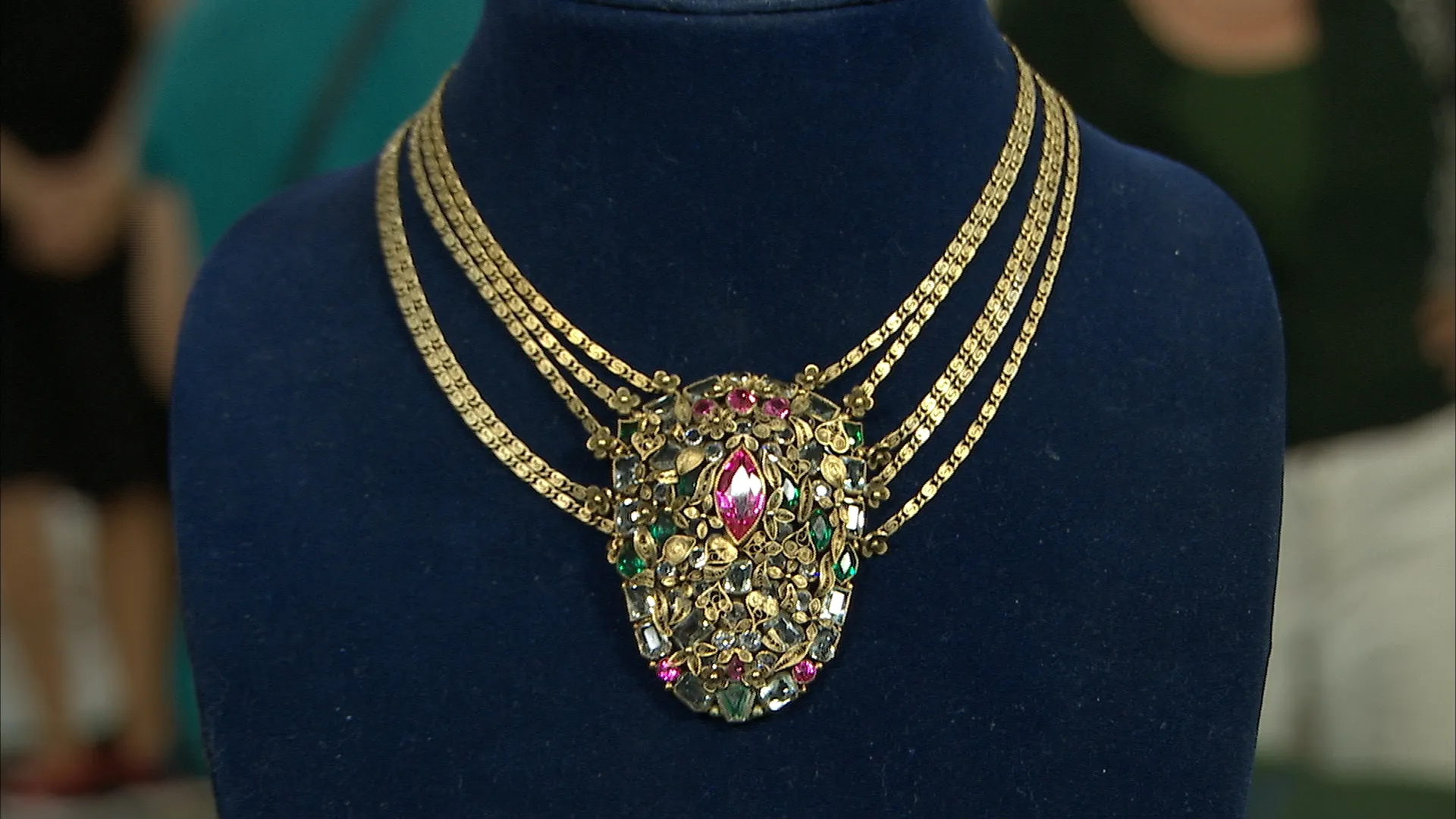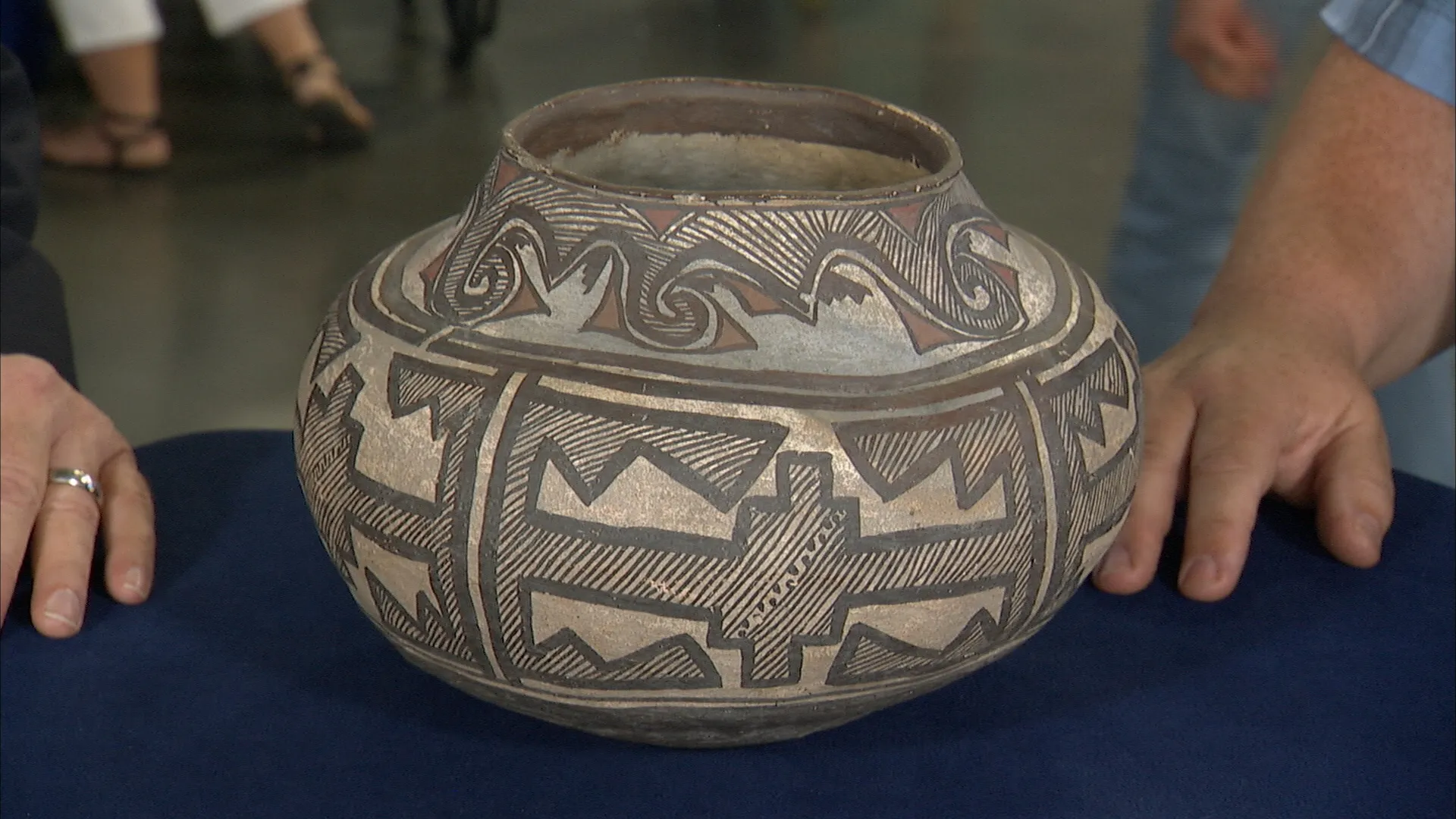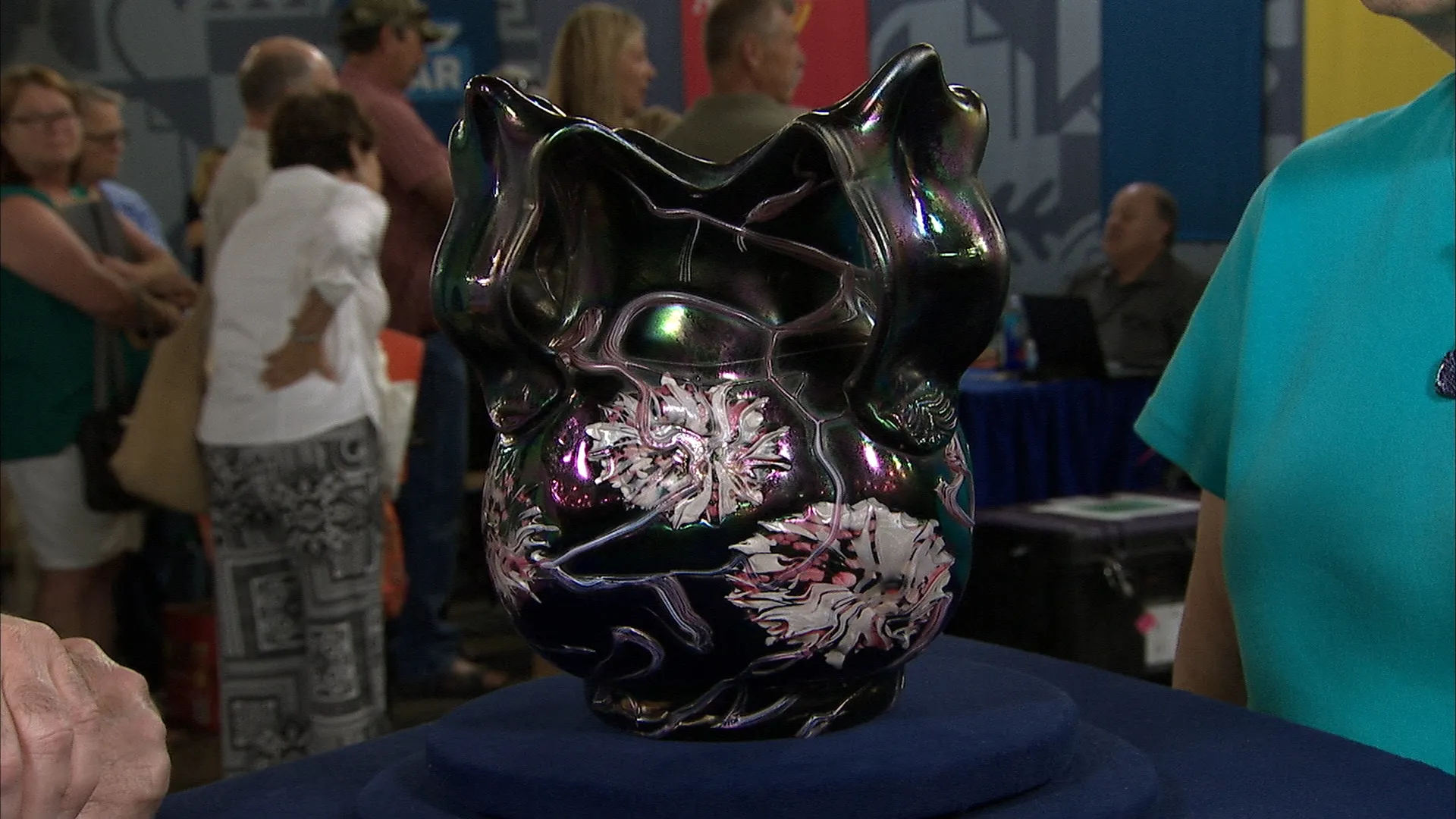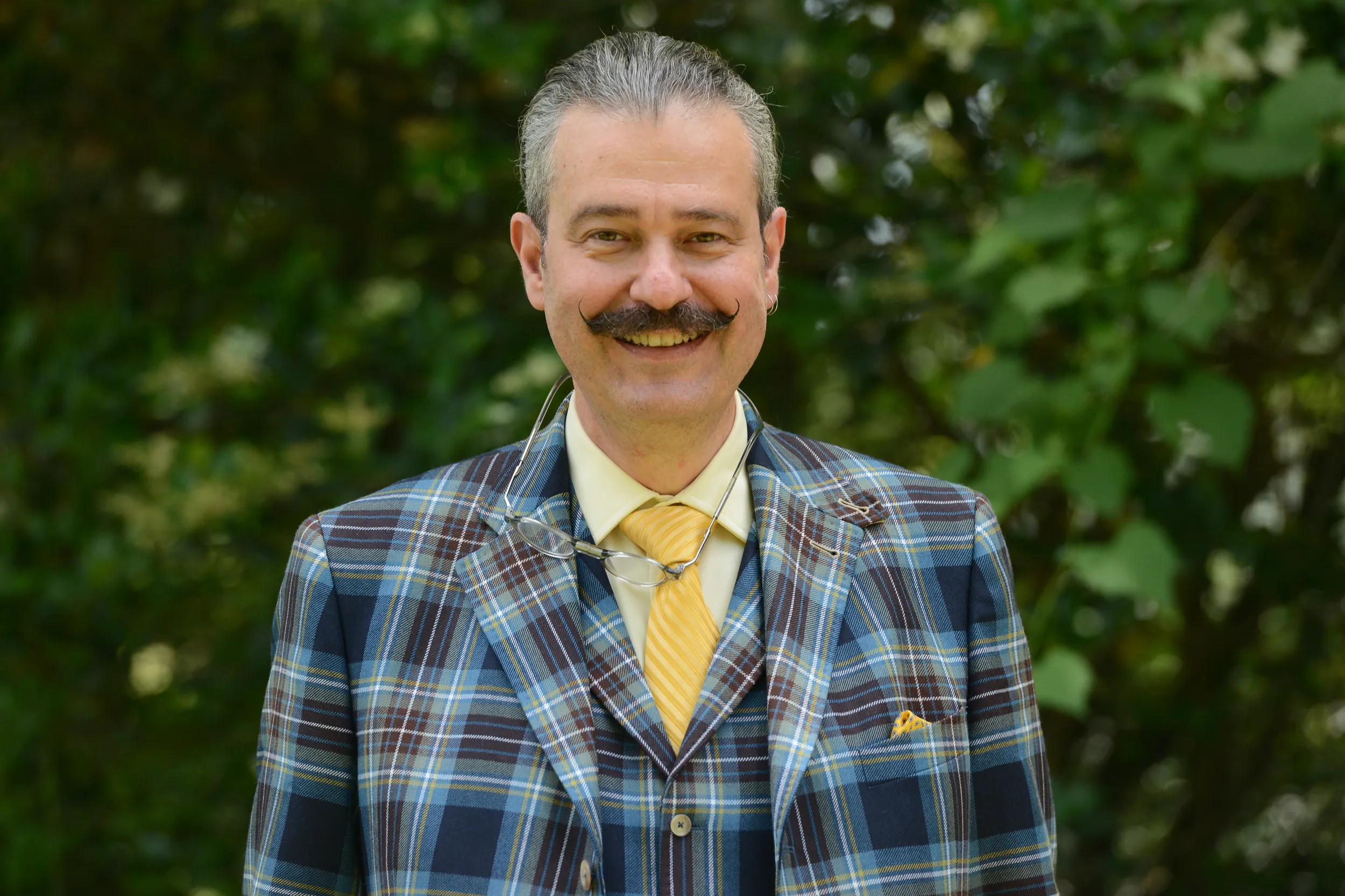HOST: ANTIQUES ROADSHOW is checking out thousands of treasures in Salt Lake City.
GUEST: We just call it "the monstrosity." (laughing)
APPRAISER: It's one of the most wonderful things I've seen at the ROADSHOW in many, many years.
GUEST: Oh, you've got to be kidding.
HOST: Birds of a feather were flocking together in Salt Lake City, when ANTIQUES ROADSHOW visited the Tracy Aviary. And other winged wonders like this macaw had crowds to wow. (audience cheering, whooping) From a bird show, back to the ROADSHOW, check out these wild cats in the spotlight.
GUEST: I got it from my father-in-law. He was a high school art teacher, and he collected posters. And he produced posters during World War II. And this was one of his, in his collection.
APPRAISER: And how long have you had it?
GUEST: We've had it about ten years. I don't know how long he had it before that.
APPRAISER: There are some important differences between this and many other circus posters. The first thing is that it is larger than usual.
GUEST: Yeah.
APPRAISER: And that's because it's a four-sheet circus poster. There are one-sheet posters, there are six-sheet, there are eight-sheet, there are 12-sheet and there are 24-sheet gigantic barn signs, but this is a four-sheet. And very interestingly, on the back, there's one place where it actually has a stamp on it that says, "four-sheet, black leopards poster." When a poster is linen-mounted, the stuff that's printed on the back is covered up so you can't see it. So on this non-linen mounted poster, it's completely visible. Also, it has been pasted together. Originally it would have been four separate sheets that were just pasted up onto the wall. So it's nice to see these four sheets put together in a rather archival and good way. I also see a poster that's printed by one of the preeminent lithography companies in America, the Strobridge Litho. Company. The Strobridge Litho. Company really did wonderful posters. And posters that were printed by them carry somewhat of a premium in the collecting market. I also see something else. I see by you the name "Alfred Court," as the animal trainer who's being promoted. But if you notice, that's actually a separate piece of paper that has been not so expertly applied.
GUEST: Yeah.
APPRAISER: And what that is covering is the name of an earlier animal trainer, Terrell Jacobs, who had worked for Ringling Brothers prior to this. Doing my research, I discovered that Terrell Jacobs, who is literally known as the "lion king," who worked for 16 different circuses throughout the course of his life, only worked for Ringling Brothers in 1938 and 1939.
GUEST: Okay.
APPRAISER: So this poster was printed in 1938. But then it was adopted for Alfred Court, who worked for Ringling Brothers between 1940 and 1945. The one-sheet version of this, the 27 by 41 inch single-sheet version of this sells at auction for $1,400.
GUEST: Wow.
APPRAISER: Now, this is bigger, this is more dramatic, it has much better wall presence. But there's no record of it coming up for sale. So I consulted with some of my colleagues at the collectibles table, and we feel that at auction, a conservative estimate for this would be between $3,000 and $4,000.
GUEST: Ooh, good.
GUEST: It's a Mid-Century wood bowl that we think was Mid-Century. We came across it in a local auction, my dad and I kind of stumbled to it, it was in a cardboard box, and we pulled it out and started looking at the markings, and we thought, "Boy, this could be something." So we said, "You know what, let's throw $200 on it." We kind of debated about it, went and bought some other items. Then we thought more and more, "You know what, that name looks recognizable. It clearly is a skilled craftsman that did this." We knew it had to be something. So I think we settled on $557. Come to find out we were the highest winner by about $300.
APPRAISER: So when did you acquire this piece?
GUEST: Just a couple of years ago, actually.
APPRAISER: Well, what you bought was a wonderful piece of Ed Moulthrop turned wood. I've seen a lot of turned wood in my life, and this is by far the largest piece I've ever seen. It is absolutely monumental. Ed Moulthrop had an interesting career. He started off as an architect, he went to Princeton. He moved down to Georgia, where he taught architecture. In the '70s, he began to make turned bowls almost exclusively. That's what he did for a living. He has several family members that do it as well, but he really kind of pioneered this, and this look is so fantastic, and it's so classic Ed Moulthrop. I'm always curious as to how they got it this big.
GUEST: That was always my question. I mean when we see this thing, obviously one piece of wood. I've dabbled with turning bowls myself when I was younger, and I mean they had to have custom tooling or something to go after this, I would think.
APPRAISER: He had a massive personal lathe that he could do this with. Then all of his tools had very long handles so he could get to the bottom of this. All this shine on here is a glycol that he put on it, which would soak into the wood and help preserve it. One problem we have with this piece, however, is that we have several humidity cracks. The humidity here is very low. The lack of humidity sucks the moisture out and we get cracks. Right. But this piece, other than these cracks, is really fantastic. It's also signed on the bottom. And if you don't mind, can we turn it up?
GUEST: Sure, absolutely.
APPRAISER: And it's a gum wood, which is common. Edward Moulthrop loved to use wood that was kind of secondary to a lot of usages, but that was beautiful. Wood that had... been struck by lightning, or wood that had big knots on it, or wood that had been damaged and had repaired itself, and that's where all these beautiful lines come. And the lines and just the art in this piece is just fantastic. A lot of Modern is about organic design, and this piece is just absolutely perfect for organic design. And it's huge!
GUEST: It's huge.
APPRAISER: So as far as the value, do you have any idea what you think a value might be?
GUEST: We tried to put our pieces together with what you can find online, and it's a little all over the place. As you mentioned that there are family members that carried on his tradition. Is this a genuine from Ed himself, or is this maybe one of somebody else?
APPRAISER: We believe it's genuinely from Edward himself.
GUEST: Okay.
APPRAISER: My guess it was built sometime in the 1980s.
GUEST: You think '80s, okay.
APPRAISER: It could be the 1990s. He passed away in 2003, and as far as a value goes, it's largely dependent on the size. I think at auction, if we didn't have the cracks in it, it'd probably be in the $30,000 to $40,000 range, which is a heck of a lot of money.
GUEST: Yeah.
APPRAISER: With the cracks it becomes a bit more dicey, we're not quite as sure what it'll bring. My guess with the cracks, we could safely say at auction it'd probably bring $15,000 to $20,000.
GUEST: Sure.
APPRAISER: I about swooned, you know. I thought they were going to have to like come over and give me oxygen or something, you know. It's a fantastic piece.
GUEST: Well, thank you very much.
APPRAISER: What did you bring today?
GUEST: It's not a painting.
APPRAISER: It's not? What is it?
GUEST: It's either hair or thread.
APPRAISER: It does look like hair, doesn't it?
GUEST: Yes, it does.
APPRAISER: That is pretty cool.
APPRAISER: We don't see many of these in person too often. I'd expect at auction it would sell for between $1,500 and $2,500.
GUEST: Oh, really? Well.
GUEST: I was told it was 1860s with amethyst on the front.
APPRAISER 1: I would say design-wise, it's definitely mid-19th century. And we'll have to get one of the jewelry people to look at the amethyst to tell you more about that.
APPRAISER 2: It's garnet.
APPRAISER 1: Okay.
APPRAISER 2: Amethyst you'd see a little bit of purple.
GUEST: I was lucky as a kid to go to the premieres, you know, before it came out. And somehow my dad knew somebody along the line, and I ended up with the poster after each year they came out.
APPRAISER: So you got to see Star Wars in the theater.
GUEST: Yeah. I got to see the premiere of each one of them.
APPRAISER: How amazing was that?
GUEST: It was pretty cool. I mean I was 11 when this came out. So it was a pretty awesome experience.
APPRAISER: Well, you have the iconic posters from one of the greatest movie franchises of all time. You've got an original Star Wars one sheet. It says down here, "one sheet style 'A'." Which is why we call it the Star Wars "one sheet style A." And then we have Empire Strikes Back. We call this the Gone with the Wind. The wonderful little pose of Han Solo and Princess Leia. And this is called the Empire Strikes Back one sheet. And then back here we have a different version. The one sheet B. It's not nearly as iconic, but it's still a very, very popular poster. And then we have Return of the Jedi down here. This is one of the two standard poster styles from Return of the Jedi. Now, have you ever had these valued?
GUEST: I haven't. We haven't looked at them for over 30 years. They've just been in a closet.
APPRAISER: We estimate at auction for these four posters in this condition, which they're still in wonderful shape, between $2,000 and $3,000 at auction.
GUEST: Holy cow. Wow. That's... really impressive. Very cool.
GUEST: It was built by my father's maternal grandfather. He was an ironworker, and I guess this is what he did in his spare time. We got it about 25 years ago and have been hauling it around the United States since then. We just call it "the monstrosity," because it's so large and so heavy, it seems to fit.
APPRAISER: And his name was?
GUEST: William Himsel.
APPRAISER: We believe this is a scratch-built birdcage/aquarium. Scratch-built meaning one of one, by a mechanical artist in the 19th century. And where was he an ironworker at?
GUEST: I think he was in New York.
APPRIASER: Well, that answers one of the questions that we didn't know, which was is it European or is it American. And that really takes us back into a time in America where we had much more focus on the mechanical arts. And there were more people that could do these complex projects. It begins with this clock tower, descends down to these balconies with the railing with the initials of your great-grandfather.
GUEST: Right.
APPRAISER: It's flanked on each side by a birdcage. And these are really quite unique, too, in the sense that they... you can see how you feed the birds through here. Underneath it then is an aquarium.
GUEST: Mm-hmm.
APPRAISER: That's completely water-sealed, and to our left-- and we can see this is interesting-- that this is canted, where this side is flat. And that's to house...
GUEST: Right.
APPRAISER: ...this steam engine. And this was, our thought is, to power the aquarium, to aerate the aquarium. But I'm thinking it had more function than that.
GUEST: Yes, quite a bit more. The piece of furniture beneath it is actually a dry sink that this sits in. And underneath is a whole bunch of machinery that runs the pump for the aquarium and the motor for the elevator.
APPRAISER: Correct, and let's take our viewers back behind it, and they can see this elevator. You've got this staircase modeled after a commercial building that you'd see in America at the end of the 19th century. The shaft is there, the car is there. My thought is that this was built in 1886, and then remodeled at some time or renovated at some time. There was electricity added at a later date. And the coating on the deck of the cabinet I think appears later. You did bring us a very visual image that helps us out quite a bit. It shows us exactly what it would have looked like, at least in the mid 20th century.
GUEST: Right.
APPRAISER: Another thing that we didn't show our viewers on the inside of this because it's difficult to get to, this is a gasolier.
GUEST: Oh, okay, I didn't know that.
APPRAISER: That is lighting the cage and is also providing light to the aquarium as well.
GUEST: Okay, so the small pieces coming up out of the chandelier, that's to emit gas that you would light?
APPRAISER: Correct.
GUEST: Wow. I didn't know that.
APPRAISER: As one appraiser said, it's really a torture chamber for birds. (laughing) They were equally confused about what it was as we were about price. We didn't... we didn't necessarily agree on it. I think the consensus is that we feel safe with an auction estimate of $3,000 to $5,000.
GUEST: Mm-hmm.
APPRAISER: And I think one of the reasons we're keeping it down a little bit is simply because it would take a lot to get this functioning again and showing the way it was intended.
GUEST: And we're actually interested in doing that. We're determined to keep it in the family, and keep it up as well as we can.
APPRAISER: Thank you very much for bringing this large, wonderful vase. When did you get it?
GUEST: It was in the early '70s, a gift from my husband.
APPRAISER: This is Japanese.
GUEST: Oh, Japanese.
APPRAISER: Japanese Meiji period vase, which is more into late Meiji period, early 20th century, porcelain vase. This shape I've seen very often. This size, not too often, very tall. It has a design of shochikubai, which is… sho is this one, pine, with the snow on, and chiku is bamboo. Do you see the bamboo here? Very nicely... colored.
GUEST: Oh, I see.
APPRAISER: Bamboo, pine, and plum. So that's auspicious symbols in Japan. And this has a very nice decoration, which tells you it was made in Arita area, which is in Kyushu, southern part of Japan. There's a signature on the bottom. I think we've seen it here. It says "Ao," which means blue in Japanese.
GUEST: Blue?
APPRAISER: Yes.
GUEST: Oh.
APPRAISER: I'm not sure if it's the name of the maker, but it's probably the name of the studio. This is the top part, this is the bottom part, "Ao." I have seen this artist, but never knew the artist's name. But I have seen this mark.
GUEST: You have.
APPRAISER: Quite a while, yes. Ooh, it's heavy. So the important question: how much is it?
GUEST: Right.
APPRAISER: In auction, it would be about $3,000 to $5,000. So this is what you expected?
GUEST: Ah, no. It was appraised several years ago, actually in the '70s, and it was appraised at that time between $30,000 and $40,000.
APPRAISER: Oh right, yes. Maybe because in '70s and '80s, Japanese art was booming, but now it came down, and it's been down.
GUEST: $3,000 to $4,000, I wouldn't sell it for that.
APPRAISER: $3,000 to $5,000, yes. In auction, maybe it might go up, but that's the price. I think you should insure it for $6,000, $8,000.
GUEST: $6,000 to $8,000?
APPRAISER: $6,000 to $8,000 or so.
GUEST: Okay. Thank you very much.
APPRAISER: You're welcome.
APPRAISER: It's more expensive to frame this thing than the value of the piece. Because something like this is going to be worth $150, $250. And a frame would be probably $500 to $1,000.
APPRAISER: It looks like it's going to do something fun.
GUEST: So yes, the slide goes all the way down.
APPRAISER: Oh.
GUEST: It's like a wide mouth.
APPRAISER: Look at that. (chuckles) I've never seen one quite like that.
APPRAISER: These are very desirable because doll collectors like to dress these up like Grandma. (laughs) And you know, put them in a bed, and then the Little Red Riding Hood would be next to it. Because it's very hard to find a wolf that's kind of really wolfish looking.
GUEST: Yeah.
APPRAISER: So I've seen these retail for as high as $400.
GUEST: Okay.
APPRAISER: Yeah.
GUEST: My grandma had given me this. She got it from her mother-in-law, who owned a restaurant in Bremen, Germany. And after the war, she would have people come in and just want to trade things for food. They just needed food more than they needed their things. She had acquired a lot of things over the years at that restaurant, and this was one of them. I know it's Russian. My grandmother had once translated it for me, and I know it says something about Christ being resurrected.
APPRAISER: On the front it says, "Khristos Voskrese," which means "Christ has risen." Generally they would be given as Easter presents for Russian Orthodox Easter. It's silver and champlevé enamel. What you have here is a work by the firm of Khlebnikov.
GUEST: Okay.
APPRAISER: Which is one of the real important names in Russian jewelry. Khlebnikov was an imperial court jeweler. They were very famous for being silversmiths, as well as working with enamel. And if we open it up, you'll see the gilt silver wash, and there's Russian silver hallmarks, which say "88." 88 is the silver purity.
GUEST: Oh, okay.
APPRAISER: And then it has a town mark, which is the town mark of Moscow. And it also has a maker's mark of Ivan Khlebnikov, "I. Kh." in the Russian initials. Now even though Ivan Khlebnikov was originally from Saint Petersburg, he moved and set up shop in Moscow in the 1870s. And he died around 1881. That is the time period. I would put an auction estimate of about $2,000 to $3,000 on it.
GUEST: Wow.
APPRAISER: And I think that's conservative.
GUEST: Wow.
GUEST: I often went to San Francisco and met a friend for the antique shows. I happened to find it in a dealer's booth, and it really appealed to me just as a folk-art kind of a decorative object. I really knew nothing about it, I don't really collect folk art, but it just spoke to me. We negotiated a price, and I bought it.
APPRAISER: Well, it is extraordinary. It's absolutely a whimsy, I would say.
GUEST: Yes.
APPRAISER: And you're right about its folk-art roots. If we just turn this around we'll see how it is carved three-dimensionally, and it has got flowers and vines. I think it's working off of a tradition during the Victorian period. You see a little date here on the bottom. Looks like it says "1800." But we get closer to it, and we notice it probably was "1890."
GUEST: That... I would think so.
APPRAISER: It's very difficult to determine actually where it was made. It's definitely an American piece.
GUEST: American, yes.
APPRAISER: For sure, but where in the United States, hard to tell. All of these little whimsical things going on. I mean he's got shoes, and knickers, and he's got a little dog.
GUEST: The dog sold me.
APPRAISER: There's also a little loop in his head. We had chattered earlier that there was some provenance.
GUEST: It's certainly unofficial, but this is how I remember it. I bought it from a dealer in San Francisco I saw often. She said that it had been in Tony Duquette's estate, who was an interior designer, a creator, he did set... movie sets. And the reason she said it has the little eyehook at the top is he used it as a hanging object, and it hung above a bed.
APPRAISER: Do you mind telling us what you had paid for it? I would say between $500 and $800, and it was maybe 15, 18 years ago. And I remember thinking that was a lot of money.
APPRAISER: What I love about it is that it almost feels like it's a marble statue, but in fact it's painted wood.
GUEST: Well, I even thought ivory.
APPRAISER: Yes. The fact that the figure is seated, it gives you this very regal air to it.
GUEST: Yes.
APPRAISER: And there's a tiny little bit of polychrome decoration on it. It's a wonderful piece. We bantered it about, actually, at the folk-art table. I think we're up to the $5,000 to $7,000 range...
GUEST: Wow.
APPRAISER: Would be a good auction estimate on this piece.
GUEST: Pretty good for liking a decorative object.
APPRAISER: Yes, yeah.
GUEST: So much for initial attraction.
APPRAISER: Yes, yes.
GUEST: They were in the family long before I was in the family. The movie actor James Gleason, character actor, but he also wrote the screenplay for The Broadway Melody, the second Academy Award, and played polo with Will Rogers, partied with the Hearsts. My parents were friends of his servants. But he liked my parents, more or less adopted them and my sisters, older sisters, and just gave us stuff. He gave my dad a Woodie car, and my sisters a horse. Just wonderful things. I came along much later in life, he died when I was seven, and I got these just down from the family.
APPRAISER: They are objects of their time. About 1930, perhaps a little bit earlier. They were made right in the heart of the Art Deco era in Paris. And they are very Art Deco in their own way. The term Art Deco is a fairly modern term, first coined in 1966. And it's kind of an umbrella term to describe all of the decorative arts that were shown in Paris at an exhibition in 1925. These are porcelain flasks for holding liquor. They were designed in Paris in Limoges by Margerie, who signed them here. There was a gentleman called Georges Bastard, who was something of a celebrated decorative artist in Paris. He was born in the early 1880s, died in 1939. He was very much at the forefront of the Art Nouveau movement, and made a transition into the Art Deco movement, by which time he was working in Limoges, and he commissioned this fellow Margerie to design a range of these porcelain flasks, this one representing a tennis player and here a boxer. There was a number of them representing figures in sports. And I love the vitality of these two characters. The boxer, by the way, was made in a pair. There was an opponent to him also. Any work by Georges Bastard is rare, and much admired. The provenance from James Gleason doesn't hurt the value, but it doesn't help it dramatically.
GUEST: Yeah.
APPRAISER: The tennis player I believe is the most valuable one. He's certainly the most elegant, the most striking. And I believe if he came up in a good auction, you would expect an estimate of at least $700, and perhaps $900. Great. The boxer I think somewhere between $400 and $600.
GUEST: Great. That's certainly more than I thought they were worth.
GUEST: My son was in the Peace Corps over in Armenia from 1996 to 1998. He found this rug, and the man who sold it to him said it was very old. So he thought I would like it because I have a... kind of Native American art, and he thought it would go well.
APPRAISER: Was it a dealer or did he buy it from a private home?
GUEST: I think he bought it from a private home.
APPRAISER: Okay.
GUEST: Yeah, they'd had it in their family I think for a while.
APPRAISER: This happens to be a rug that was made around 1900.
GUEST: Oh wow, I didn't realize that. So it's pretty old.
APPRAISER: Yeah, and one of the ways we can tell that is that it has the beautiful range of natural dyes. Because after 1900, they started using the synthetic dyes, which are very garish. In terms of the type of rug, it's not an Armenian rug.
GUEST: Oh, it isn't?
APPRAISER: No. I believe it's a rug woven by the Shahsavan tribe, which was sort of in Azerbaijan, bordering on the Caucasus.
GUEST: Oh, okay.
APPRAISER: And by 1900 they were making rugs not only for their own use, but they were making them for the marketplace. Now, the type of rug, it's called a kilim, and kilim refers to the technique, which is a slit-weave tapestry technique. And if you look very closely, there are these little separations where they have to turn the color one way and go back the other way. They have to create a slit.
GUEST: Oh, okay.
APPRAISER: But the majority of the rug is done in plain weave bands that don't require any slits. But this wonderful combination of the plain bands and the pattern creates a really great graphic, and it's not surprising to me that your son thought that it was very evocative of your Southwest theme.
GUEST: Yeah.
APPRAISER: Another hallmark of this type of rug is this beautiful macramé plain weaving at the top, which is very labor intensive. It's so nice when that remains intact in the rug. How do you tend to use it in your house?
GUEST: Well, my son passed away about... it'll be ten years in November. And after he passed away, I hung it on a bed spread holder so it's draped over it, and then I have a picture of my son on the... on it, on the top.
APPRAISER: Oh...
GUEST: And then a poem underneath of his picture.
APPRAISER: Oh, that's really sweet. That's really sweet.
GUEST: So it's kind of in a corner where you... it's the first thing you see as you come down in our rec room.
APPRAISER: That's fabulous.
GUEST: Yeah.
APPRAISER: Well, the rug is in extraordinary condition. They often hung these on the wall, and they wouldn't be too discriminate in terms of how they would hang them. So, actually, there's a tear in the corner at the top, and also at the bottom at the opposite corner. This is a very easy fix for a restorer to re-weave that corner. There's so little that needs to be done to put it in perfect shape, I would recommend doing that.
GUEST: Okay.
APPRAISER: Any idea of the value?
GUEST: I called my daughter-in-law when you said we might have a chance of getting on TV maybe, and so I called her and asked her. They paid $100...
APPRAISER: Wow.
GUEST: ...for the rug. So, I have no idea, I... I just... I love the rug, and it reminds me of my son, and to me it's priceless just because he bought it for me.
APPRAISER: Yeah, of course. In its present condition, the rug is worth $4,000 retail, which would also be considered an insurance value.
GUEST: Okay.
APPRAISER: With $600 or $700 in restoration, I think the value would be up into the $5,000 range on the retail level.
GUEST: All right.
APPRAISER: So it's... it would be worth getting it fixed.
GUEST: Definitely. It would mean a lot to my daughter-in-law, so I'll save it and give it to my grandson someday.
APPRAISER: Absolutely.
GUEST: We've been told by different people-- universities and scholars and such-- that there's a possibility that it's a scroll, part of the head of a scroll that might have... it's been called an artifact, and it could be part of the ancient scrolls. So that's why we kind of want to find out more information.
APPRAISER: Oh wow, that's a riddle.
APPRAISER: It's very decorative, the colors are lovely.
GUEST: Do you think it's worth more than the cost of the parking ticket?
APPRAISER (laughing): How much is the parking ticket?
GUEST: 12 bucks.
APPRAISER (laughing): I think so.
APPRAISER: I think this is maybe a Navajo eagle dancer, $150, $200. But he is impressive and very fun.
GUEST: These are paintings by my husband's great-aunt, Mabel Pearl Frazer, a Utah native artist. She taught at the University of Utah for 33 years in their art department.
APPRAISER: She was a very prolific artist.
GUEST: Yes.
APPRAISER: And what I found interesting about her is what I think we all find interesting about so many women who painted in the 20th century in America whose work is little known outside of their local regional areas.
GUEST: Right.
APPRAISER: This tends to be because most women didn't have the same opportunities that men had to exhibit their work. She's a beautiful artist with an extraordinary color sense. And there are very, very modernist tendencies in her work.
GUEST: Yes.
APPRAISER: The way she's kind of abandoned a realistic way of depicting something for these flattened kind of planes. This picture is almost surreal in some ways. It's highly dramatic. Given the interest there is increasingly in these women artists of this period, I would not be surprised to see an auction estimate of between $5,000 and $7,000 on the larger of the pictures, and perhaps $3,000 to $4,000 or $3,000 to $5,000 on this one.
GUEST: Wow.
GUEST: My doll has been in the family for at least 50 years. And before that, I'm not sure where exactly she was. I was... I have not a lot of information. I was told that she was a French fashion doll. My parents were antiquers. On Sundays they would go to different antique shops in Massachusetts, and because I was the youngest I got to go too. Not very long into that I hated it. One Sunday-- I used to stand in the corner while my parents would look at all the furniture-- there was this doll, and my mother said, "Do you like it?" And I said, "Oh yeah, I really like it." So they bought it, took it home. It was my doll, but I wasn't allowed to play with it.
APPRAISER: (chuckles)
GUEST: It was put behind glass and I could look at it. And because I'm a real hands-on doll person, I kind of went, "Well, no big deal there." As my parents got older, we were breaking up the home, and I was talking to my mother and I said, "Can I have my doll?" And she said, "That's not your doll." And I said, "Oh." So when my mother passed away, my sister said to me, "Would you like your doll?" So she came back into my family. We knew that she was probably worth a lot of money since it's the original outfit, so we took her to this doll hospital, and that was kind of creepy. The man that came to the door was very interesting looking, and we walked in, and the dolls were all in pieces, and they were all staring at you because they're all hanging on the walls. And it was very dark, it was just not pleasant. And then there was another man there who had a very long beard, and he looked at the doll and he said, "Can we keep her to evaluate her?" A week later they called us and said, "You've got to come down, you've got to come down. This is the highest-priced doll we've ever saw." Really. So we went down and they said, "She's worth $16,000." And we went, "Okay," and just kind of... So then a few years later, we went to this wannabe roadshow-- it was not the ANTIQUES ROADSHOW. And we had her evaluated again, and they told me it was worth $3,000, and they wanted to purchase her. And my husband's, "Oh no, she's worth $16,000." And again, it was, like, really?
APPRAISER: It's very inappropriate and unethical in our business to offer to buy something after we appraise it. This is a little doll made by Schmitt et Fils of Paris, France. So she is a French doll. She's not a French fashion doll as you described, but she's actually a French bébé. She's in her original French costume with her little straw hat, her little lace dress, her wonderful socks and original labeled shoes. She's made of bisque, and she has paperweight eyes and a composition body. When we turn her around, we will see that she is marked. And it's very difficult to see under her little wig, but there's a little shield mark with "SH" in it, and that stands for Schmitt. And then we have "000". I saw that. And then also on her bottom we would see that it's marked the same way. She has pierced ears with her most likely original turquoise earrings. These dolls were made in the 1880s.
GUEST: Oh, wow.
APPRAISER: And they were sold as the finest French dolls.
GUEST: Fabulous.
APPRAISER: Beautifully made, very excited to see her. So now we need to decide if the fake appraisal fair, or the weird man with the long beard...
GUEST: (laughs)
APPRAISER: ...is right about her value.
GUEST: Okay.
APPRAISER: A little doll like this at retail would sell for $16,000 to $18,000.
GUEST: Oh, my goodness.
APPRAISER: I've even seen them at auction sell for more.
GUEST: Wow.
APPRAISER: Very desirable, high-end doll.
GUEST: Well, I guess I shouldn't have laughed. (laughs)
GUEST: Originally, I got a three-volume set of these Nature volumes. I got this one along with it. This was one I was originally interested in, but...
APPRAISER: You kind of put that in.
GUEST: This one is much more my favorite, being a scientist.
APPRAISER: Yeah, so it's a package kind of...
GUEST: It was a package deal. About $10,000, I would say.
APPRAISER: About $10,000? What you brought is a journal that includes a paper from April 25, 1953. A very important date to somebody like yourself, who I learned is a molecular biologist, done some study in that field.
GUEST: What we have is the actual journal, as scientists would have beheld it, that's signed by Dr. James Watson, and the discovery of the double helix.
APPRAISER: Exactly.
GUEST: And back in Britain, when they did this, it was very, very controversial at first. But this simple paper changed the world.
APPRAISER: This is a volume, it has multiple papers from each issue of the magazine Nature. April 25, 1953, it's just a page, and on the back is a little bit more, and that's it. The beginning of it is just so amazing. "We wish to suggest a structure." So what we have here is really one of the most important scientific papers ever published. This is the journal issue, we would call it, from a book point of view.
GUEST: Yes.
APPRAISER: As opposed to the off-print issue, which would have been maybe given out before it was bound and published and sent out. So this is the transmission of one of the greatest discoveries in all science. Watson and Crick came up with the structure of the DNA. They didn't discover DNA, that's kind of the mistake that a lot of people think. Watson and Crick discovered the structure, and that double helix shape is kind of forever they're associated with. But what's special about it is this very distinctive hand. I've seen it before many a time. It's the very simple hand of Jim Watson, Dr. James Watson. And you had him sign this, is that correct?
GUEST: I did. We were actually at a conference, and I gave him some beer to sign it. So evolution amber.
APPRAISER: You bribed him.
GUEST: He loved it.
APPRAISER: And it worked.
GUEST: Yeah. He would have signed it without the beer.
APPRAISER: Now over here we said the double helix is the structure. Jim Watson in 1968 wrote about the exciting discovery, and it really was a race to the discovery of DNA.
GUEST: It was amazing.
APPRAISER: It was an amazing book. The book is one of the most popular and famous books about a scientific discovery. And you have a nice copy, in its dust jacket, and here you've got it signed by the author, James D. Watson. Also it's signed by his partner, Francis Crick.
GUEST: Yup.
APPRAISER: Who had an on-again, off-again association after their discovery. That's special. How did you come to this?
GUEST: This particular copy I actually bought, but it was incomplete because I needed Dr. Watson's signature on the other page, which is signed.
APPRAISER: Yeah, which is really nice because back here is a picture of the two.
GUEST: That's a classic.
APPRAISER: That's a classic photo of them at Cambridge, with the structure behind them. Here's Crick, here's Watson-- young Watson, he's 24 years old-- looking up at their discovery. It's signed by Francis Crick, you said, and then you had it signed?
GUEST: I had Dr. Watson sign that one again.
APPRAISER: What you did was you completed it, and you did balance it out. It seemed asymmetrical to me. Yeah, literally to have them both there in front of that iconic image is in itself quite a valuable little piece there. A fine copy and dust jacket of The Double Helix. I've seen them retailing $1,000, something like that. Signed by Crick is unusual because it's a book by Watson. Signed by them both, Crick has passed away since '04. Watson is still with us, thankfully. What you've got here is a book now that's been elevated to, I would say, an auction estimate, now this is going to be somewhat conservative, we'd put $6,000 to $8,000 as an auction estimate on that.
GUEST: Wow, that's amazing.
APPRAISER: Now, this journal, it's interesting because the other form, when it comes out separate, signed by both, has sold for as much as $30,000 for the off-print.
GUEST: Sure.
APPRAISER: I, like you, appreciate the journal issue. It's not signed by Crick, unfortunately.
GUEST: Right.
APPRAISER: That would be nice. But signed by Watson, I still think the journal issue of that would be in that same $5,000 to $7,000 auction estimate.
GUEST: Oh.
APPRAISER: Maybe $6,000 to $8,000. I mean it's fantastic. Not bad for an old library book. At the auction market, material like DNA has just risen dramatically.
GUEST: Really?
APPRAISER: We sold a letter from Crick to his son, his 13-year-old son, three years ago.
GUEST: Sure.
APPRAISER: That letter went for over $5 million, and he was outlining the discovery before it was published in Nature.
GUEST: Wow.
APPRAISER: For insurance, you're looking at at least a $20,000 value to insure the both of them.
GUEST: Great.
GUEST: It was, I think, about 1965. My family moved from Colorado to Washington, D.C. My dad took a job with the Department of Agriculture. And my sister already played the viola. She's two years older than I am. She was already in junior high. I would have been starting sixth grade, so my mom wanted to start me on an instrument, a string instrument, and we chose the violin. So we went to downtown Washington, D.C.
APPRAISER: Did you buy it at a violin shop from a violin dealer?
GUEST: Yes, and it was hanging from... all these... I don't know how many, 50, 60 violins hanging from the ceiling. I mean, they must have been down low enough that you could grab them. But I just remember walking into this room, and I saw this violin and the back of it is kind of white, and then it goes out to brown. That's what caught my eye first. But then when he got it down for me, it has a wax seal on the back...
APPRAISER: Oh yeah, okay.
GUEST: ...that say "M.D."
APPRAISER: We're going to look at that.
GUEST: We lived in Maryland, so I thought, "That stands for Maryland."
APPRAISER: An owner who owned it at one point put his seal on the back.
GUEST: Oh. When my dad saw the cost...
APPRAISER: And how much was that?
GUEST: It was $600 in 1965. But we bought a brand-new car to drive across country, and it was $3,000. And so $600 of that, at the time I'm a kid, I'm like 11 or 12.
APPRAISER: Seemed like a lot of money.
GUEST: Yeah, it was a big chunk of money at that time, and my dad went ahead and bought it for me, the one I wanted, so.
APPRAISER: We looked at the label inside, which is now a bit obscured, and you'd found a date on the inside. 1760 is date. I can't really make out what the label says, but I can tell you the violin is made about 1750, 1740. It looks like a fake label put in later at some point.
GUEST: Okay.
APPRAISER: And probably nothing to do with the instrument. But the instrument is German, maybe made in Nuremberg. Maybe Vienna, but I think more like Nuremberg. One of the better families of makers, perhaps the family named Widhalm, W-I-D-H-A-L-M, Widhalm. It reminds me of Widhalm instruments. And one of the reasons it does is not just this beautiful outline with these beautiful small edges and little corners, but also this really intricately carved head. Beautifully carved, really clean work, and it's the kind of work that was not quickly done. This is not a commercially produced instrument. This is definitely hand made by a small workshop or a particular maker. And very high grade of work. And this was...
GUEST: By craftsmen.
APPRAISER: ...stylistically, I think their Amati model, which is a very common model of the period. The fact that the wood is not very fancy, that's okay. It's not unusual to have plain wood for these German makers. All of this brown dark finish, that's original to it. And this used to cover the whole instrument. Over the years, that all gets worn down. And also what's interesting is this violin retains its original neck. Generally speaking in the 19th century, most of these short neck instruments of the earlier periods had their necks removed and then they would remove it right at the base of the head, put a longer neck in, put the head back on and have a longer neck to play on. This one has the original neck, and it was re-angled at the heel by adding wood to it. It's been modernized.
GUEST: Oh.
APPRAISER: Well, 19th century modernized. It wouldn't take much to get this up to snuff cosmetically, but basically structurally, it's great. There are some old cracks in the head, but I'm not that bothered by that. In a retail shop environment, it should be worth at least $10,000. I'm thinking somewhere between $10,000 and $15,000.
GUEST: Oh, you've got to be kidding.
APPRAISER: No, that's about right. And overseas in Germany, where the market is even a little stronger for this type of instrument, perhaps even more. So perhaps if this were cleaned up a bit, and it were brought up to modern standards, maybe even getting up towards $20,000.
GUEST (voice breaking): Oh my goodness. That's... (laughing, crying) That's incredible. It makes me miss my dad even more, he's gone.
APPRAISER: Oh...
GUEST: You know, as I looked at the... how much he paid for it growing up, I realized it was a huge amount for that day and time.
APPRAISER: But a good choice.
GUEST: And I'll bet if my dad knew how much it was worth, he would still pay that much.
APPRAISER: It would make him happy.
GUEST: He loved us that much.
APPRAISER: Are you still using it?
GUEST (laughing): Yeah, I still play it.
GUEST: My dad gave it to my grandma as a Christmas present. In like the '80s. He paid $100 for it.
APPRAISER: Guess what it's worth. About a hundred bucks. (laughing) Nobody lost any money, it's all good here.
APPRAISER: I can tell you from looking at the hallmarks, the watch is English. It's approximately 1850 to 1860. And value wise, about $150.
GUEST: Oh, okay.
APPRAISER: This is artificially aged to make it look as though it's from the 19th century. But this was made around 1930. You would realize around $100 to $200 at auction.
GUEST: Okay, which is a lot more than the five dollars we paid for it.
APPRAISER (laughing): It sure is.
GUEST: This is a family heirloom that my father gave me. His father gave it to him after digging it out of a family storage unit, which was an old converted chicken coop in Rockmart, Georgia. And said it had been handed down from his family before that. And I had it in a storage unit until I came to see you today. (laughs)
APPRAISER: Your family was in Georgia, and how long had they been in America?
GUEST: Our earliest relative that we trace back came over in the mid-1630 or so from England, and he lived in Massachusetts. And then family went down after a generation to Georgia and North Carolina.
APPRAISER: I think when they were living in Massachusetts, somebody made this for them. The reason I think that is cause it's white pine.
GUEST: Okay.
APPRAISER: This is an amazing chip carved spoon rack.
GUEST: Chip carved, okay.
APPRAISER: Chip carved spoon rack. You see all those pinwheels?
GUEST: Yes.
APPRAISER: They draw those out with a compass, and then they'll take a really sharp small chisel or some small device and they carve all those pinwheels out. And it's got the heart on the top, but even more importantly, on your side is the date: 1764. This is so rare. And at auction, we think this would bring $3,000 to $5,000.
GUEST: Really?
APPRAISER: Really.
GUEST: This model was a gift from Errett Lobban Cord in 1931 to my grandfather, Lou Manning. My grandfather commissioned the Elgin Watch Company to make a model identical to this to be presented to E.L. Cord of the Auburn Automobile Company.
APPRAISER: Now what relationship did Manning have to Mr. Cord?
GUEST: They were partners, business partners, and they together purchased a defunct automobile company called Auburn Automobile Manufacturing in Auburn, Indiana. They produced three vehicles that they wanted to really stand out. There was the Auburn, the Duesenberg, and the Cord automobile, and they were way ahead of their time. This is a L-29 Cabriolet Cord.
APPRAISER: And it's made by?
GUEST: The Auburn Automobile Company.
APPRAISER: Now, this is the front-wheel drive car, and a very fast one, too.
GUEST: Very, very fast. The first front-wheel drive prototype of its type ever produced.
APPRAISER: So there were two of these. You say your grandfather made one for Mr. Cord, and then how did this one happen to be made?
GUEST: Well, I think Mr. Cord decided he would return the favor, and asked them to make another one for Lou.
APPRAISER: I see. Now as I understand it, the first one made is absolutely pristine, it's in a case in the Cord Museum with plates identifying it as being owned to Mr. Cord. Well, it's absolutely fabulous, and I have to say it's one of the most wonderful things I've seen at the ROADSHOW in many, many years. And what's amazing is the level of detail is just astounding. The rumble seat works, fully upholstered. But what's really astounding is right here you have the machined aluminum dashboard, all these dials just appropriate. The doors open with all the handles and latches, and even the windows open. Has all the features that made the Auburn a desirable car to modern collectors. The side-mount spare tires, wonderful luggage rack. Amazing, incredible detail. Now unfortunately, it's not a toy. But you and your kid brothers and everything sort of thought it was.
GUEST: Three generations played with this car. The bumpers worked well enough to stop the car, but obviously it's hit the fenders and popped the paint. And a lot of the tire rubber has come off. It's a lot of wear and tear, but since I have acquired it as a young man, I've taken as best care of it as I could.
APPRAISER: Well, it's great construction. Even really amazing is the fact that the wheels are wood, and it still has some of the rubber. It's sort of surprising also that it's just good as it is, even though you guys played with it. You have a sense of the value, I think?
GUEST: I would think somewhere in the range of maybe $20,000, $25,000 just because of what it is. But it's hard to put a price on something like this.
APPRAISER: It really is. There were a series of cars, they were Hudson models and about this big, which they made about 12 or 15 of. Highly detailed, not as great a detail as this, sold at auction for around $26,000. This, I think easily $25,000. And at auction, if you had a Cord Duesenberg Auburn enthusiast, easily $25,000, $35,000. The fact also that it has the provenance, it just adds another level to it.
GUEST: I brought some jewelry that was either my great-grandmother's, or my great-great-grandmother's. My great-grandmother was a very prominent woman in San Francisco.
APPRAISER: I see.
GUEST: And she was very much involved with the Jewish San Franciscans in the 1800s.
APPRAISER: Okay.
GUEST: And I know that they were pretty wealthy people.
APPRAISER: Do you wear them?
GUEST: I do, I wear the ring. I wear this mostly when I'm going out for black tie.
APPRAISER: What we've got is a suite of Art Deco jewelry. This is textbook Art Deco. Very geometric and uniform, platinum and diamonds. A little splash of color, we seem to have a few sapphires in here. The sapphires are probably synthetic. My guess would be is they're made somewhere in the East Coast of the U.S. I didn't notice any marks on any of the pieces. Even though they're not marked, I would bet they're not from the same maker, but definitely from the same era. In the ring, there's a mark that says "plat," which of course stands for platinum. This guy here has some old European cut diamonds in the center that weigh anywhere from about .6 to .9 carats. Not quite a full carat, but a nice size, gives it a great look. And then it's accented by three carats in total diamond weight, aside from the center diamonds. So we got quite a bit of carat weight going in there. For something like this, I would expect an auction estimate to be in the $10,000 to $15,000 range. Very nice piece.
GUEST: For the bracelet.
APPRAISER: Just the bracelet alone.
GUEST: Okay.
APPRAISER: Great piece, still in excellent condition, which is very important. In the middle we've got a great looking ring, again, Art Deco. And in the center we have an old European cut diamond. It's a nice size, it's about two carats. It's surrounded by single cut diamonds. And a good auction estimate for that would be around $12,000 to $18,000.
GUEST: Okay. (laughs)
APPRAISER: A lot of that is based on the center diamond. Of course when you've got a big diamond, that always helps us out here. And last, but certainly not least, we've got the string of pearls with a pendant on it. The center diamond in there is an old cushion cut, it's about three carats. And it's got some old European cut diamonds around it. The pearls do look like they're later, they're cultured. Looks to me actually on the pendant there, this little bail is what we call this where you put it over the pearls. That is an alteration from the original Art Deco piece.
GUEST: Okay.
APPRAISER: If you kind of look at it, the scale is a little bit out of skew. And I think a good auction estimate for that piece is going to be about $25,000 to $35,000.
GUEST: Oh, my goodness.
APPRAISER: Yeah. Lovely suite you've got there.
GUEST (laughing) Wow. Okay. I'm happy with that.
HOST: You're watching ANTIQUES ROADSHOW from Salt Lake City. What's your take on the show? Find us on Facebook and Twitter, and join the conversation. Coming up: folks recap their ROADSHOW experience in the Feedback Booth, right after this. And now it's time for the ROADSHOW Feedback Booth.
GUEST: Our watercolor is actually a print. Sweetheart, we need to invest in a magnifying glass.
GUEST 1: Mine is a Navajo.
GUEST 2: And mine is Mexican.
GUEST 1: And mine is worth $300. Yay.
GUEST 2: Mine is only worth $150, so she wins again.
GUEST 1: Woo-hoo!
GUEST: Got a great appraisal, wonderful information, and my lovely wife still hates this.
GUEST: This is our boat-- my grandpa's boat. I like it, he hates it. And they sent us to the metalwork line because we thought it was metal, but while we were waiting in line, we realized that it's plastic. $30.
GUEST: Sisters, I want you to know I left the cattle on the range and drove four hours to get here to find out that this family heirloom is worth $2.50. Next time I'll stay home with the cows.
GUEST: We had a great time, and I got to meet Nicholas Lowry. (squeals) And Kevin Zavian. (squeals) All my favorite appraisers are here, and we love the ROADSHOW.
GUEST 1: I brought this egg. It's from Russia from the early 1800s. And it was appraised for $2,000 to $3,000.
GUEST 2: I brought this peach, they said it was from the Qing dynasty, and it was worth about $400 to $600, even though it's in terrible shape. (chuckling) But today was just peachy.
GUEST 1: And "egg-cellent." (laughing)
HOST: I'm Mark Walberg. Thanks for watching. See you next time on ANTIQUES ROADSHOW.
GUEST: I found this when I was cleaning my in-laws' house.
APPRAISER: It's not signed.
Guest: Uh-huh.
APPRAISER: But I know from the style of the type of metalwork, and the way the stones are set, it's by a very famous costume jewelry manufacturer named Hobe.
GUEST: Oh.
APPRAISER: This piece was made in the late '30s into the 1940s. It's of a white metal with a gold plating. Now, the reason I know this is by Hobe is there's certain elements. These little flowers.
GUEST: Uh-huh.
APPRAISER: The way the glass or crystal is set in a serrated collet set, bezel. And they're unfoiled stones. Having a necklace is extremely rare.
GUEST: Huh.
APPRAISER: I've only seen one other necklace. On a retail level, this piece would bring between $1,000 and $1,200.
GUEST: Oh, wow. Nice. Boy. (laughs)
GUEST: My great-aunt was a schoolteacher in a little eastern Utah desert town. And a family brought her this pot.
APPRAISER: The pot is from probably the 1880s.
GUEST: Oh wow.
APPRAISER: And it's from a Pueblo in far western New Mexico called Zuni. It's a water jar. For a pot from this time period it's pretty symmetrical. If this came up at auction, I would expect this to go in the range of $1,800 to $2,200, somewhere in there.
GUEST: I inherited it from my mother. I figured by the color it must have been carnival glass.
APPRAISER: This is going to be European glass rather than American carnival glass. And it pre-dates carnival glass. This would be in the German and sort of Central European world around 1900. Probably made, although it's not marked, by a company called Palme Koenig. Conservative retail estimate would be between $1,000 and $1,500.
GUEST: Oh, okay.
APPRAISER: Okay?
GUEST: Mm-hmm, that's fine.

